
Isla Vista. The mere mention of the name brings a flood of emotions, opinions and memories to a local. A lot has happened on this small area of land in a short amount of years.
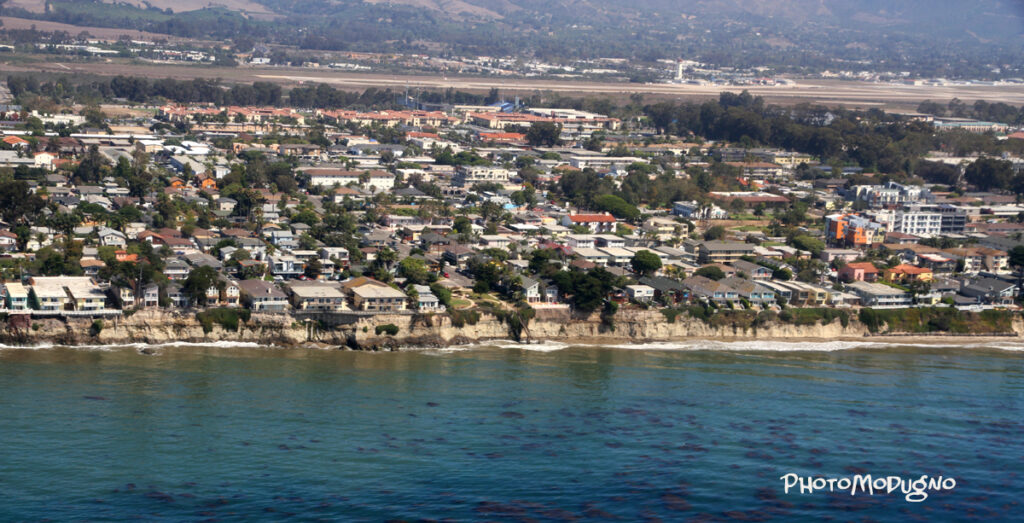
When you cram thousands of people into less than two square miles, you can expect a lot of stuff to happen. Especially when the majority of them are young and…..vibrant. Major businesses and big name bands got their start here, riots brought worldwide attention, and the parties are notorious. But why did our leaders decide to put all this housing in one little area? How did this happen? What was there before? Let’s get to the answers before those apartment buildings fall into the ocean!
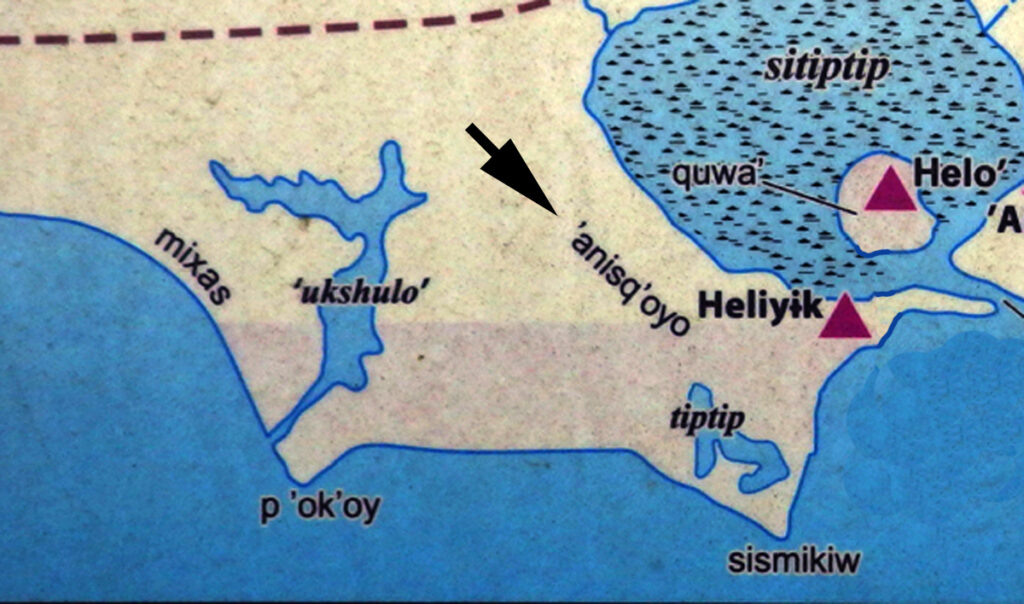
The earliest known name for Isla Vista is ‘Anisq’oyo, which means “at the Manzanita”. This name is confusing because the manzanita tree that is native to this region grows only in higher elevations. Perhaps there was a structure made of manzanita or some other manzanita related event that occurred in this area. For whatever reason, the name lives on today as a park in the middle of Isla Vista. Surprisingly, one of the most densely populated areas in California today had no Chumash villages in it, most likely due to the lack of fresh water.
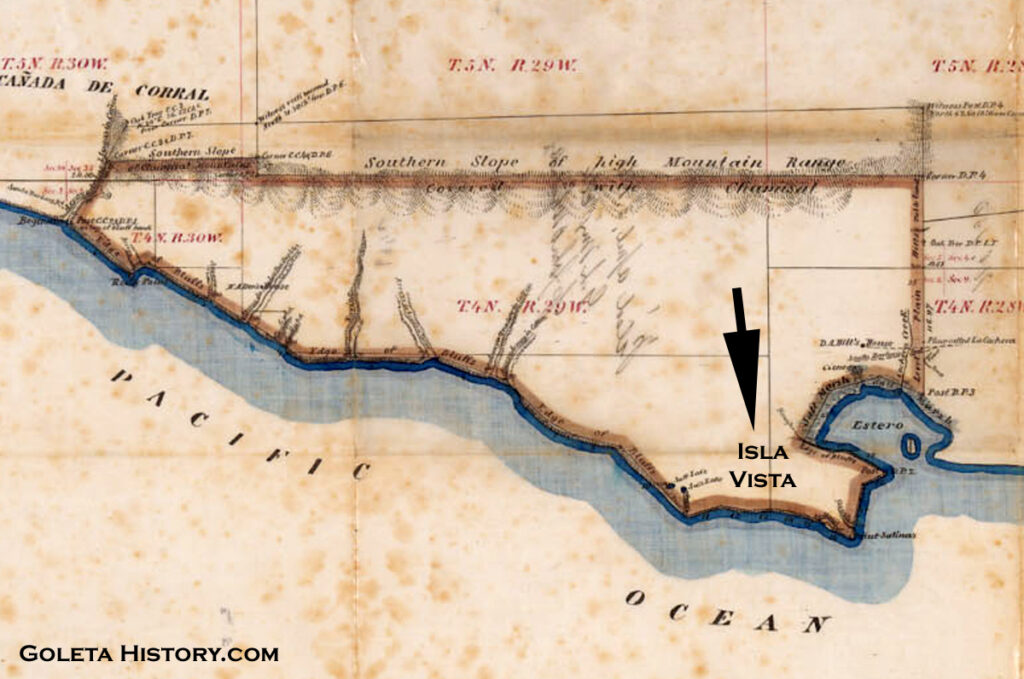
In 1842, Nicolas Den was awarded the 15,500 acre Dos Pueblos land grant that extended from today’s Goleta Slough to just east of El Capitan. Den’s massive ranch included the Isla Vista mesa, but he never made much use of this area since he was a cattle rancher, and this area was covered by a dense oak grove that made grazing impossible.

The Den family called the area from Coal Oil Point to Campus Point the “Rincon Ranch”. Rincon means corner in Spanish, and this was in reference to the sharp right angle turn on the old ranch road, shown above. Today that sharp turn is the corner of Storke and El Colegio Roads. (Also notice Campus Point is labeled as Pelican Point, one of many short-lived names for today’s favorite surf spot.)

When Nicolas Den passed away in 1862, he left half of the ranch to his wife and the other half to his ten children. Within a couple of years, several extreme weather events brought hard financial times to most California ranchers, including the Dos Pueblos Ranch. The Den family lawyer Charles E. Huse, pictured, was tasked with finding ways to keep the Dens out of bankruptcy. He took to the job with reckless abandon, often not bothering to check with the family before he took action. Ranch assets were sold and eventually large chunks of the Dos Pueblos Ranch real estate were being sold off to raise money.
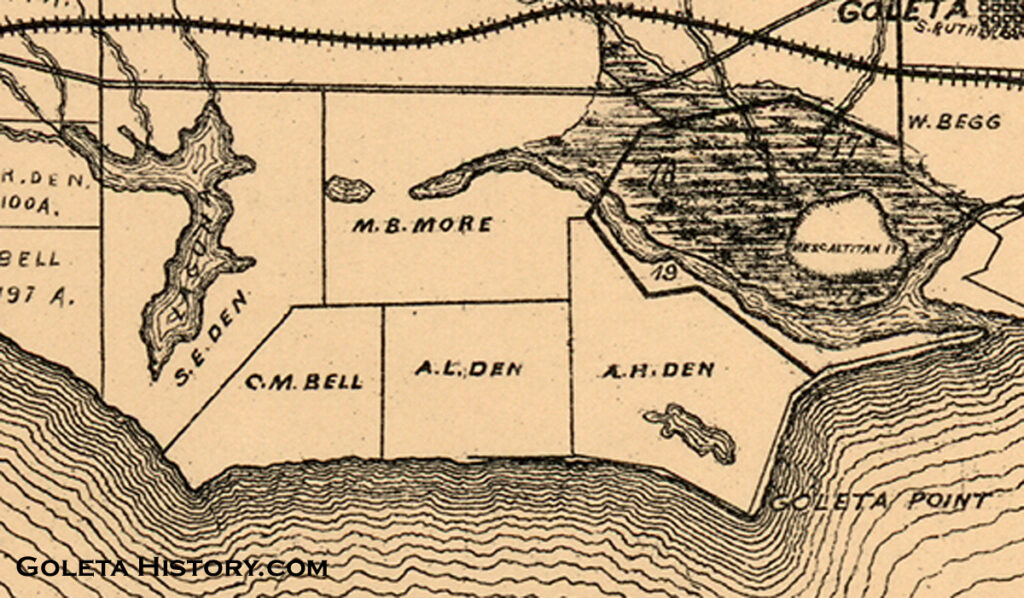
The Rincon Ranch area was split between three of the Den siblings, Catarina Den Bell, Alfonso Den and Augusto Den. Without a quality water source, the land was nearly worthless, despite the primo oceanfront location and the beautiful mountain views. There were a few 20 foot wells that produced a small amount of water, maybe enough to grow some hay or beans, but that was about it. They planted eucalyptus trees on the dividing lines of their parcels, many of which are still there today. The line between Alfonso and Augustus Den’s properties is today often called the Eucalyptus Curtain between UCSB and Isla Vista.

Charles Huse found a way to make part of the Rincon Ranch temporarily profitable. In the 1870s, he leased part of it to the More brothers and they proceeded to clear cut the live oak forest that grew there for sale as fire wood. They had an eager customer right next door at the Goleta Beach whaling station that needed fuel to melt down the whale blubber. Over 1,000 cords of oak wood were cut and sold without the permission of the Den family, and they received none of the proceeds from the sales!
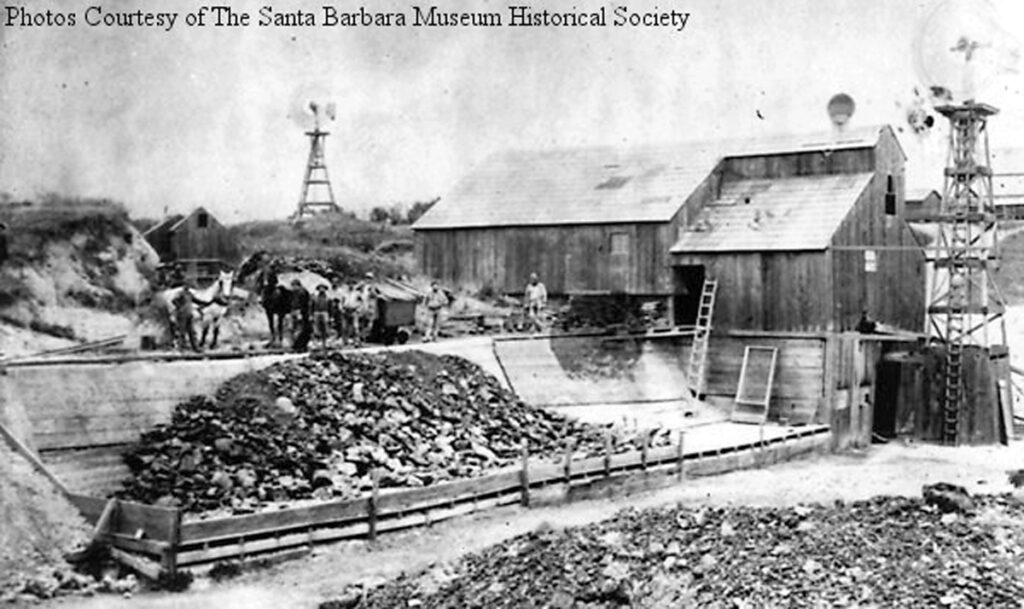
In 1890, the asphalt industry came to Goleta, and the most lucrative mine landed right in the lap of Augusto Den. The Alcatraz Asphalt Company leased part of the land that the More brothers had clear cut, and they started pulling 60 tons of asphalt out of the ground every 24 hours. What had long been considered the most worthless part of the Den family empire made “Gus” Den a wealthy man. Today this would be on the UCSB campus.
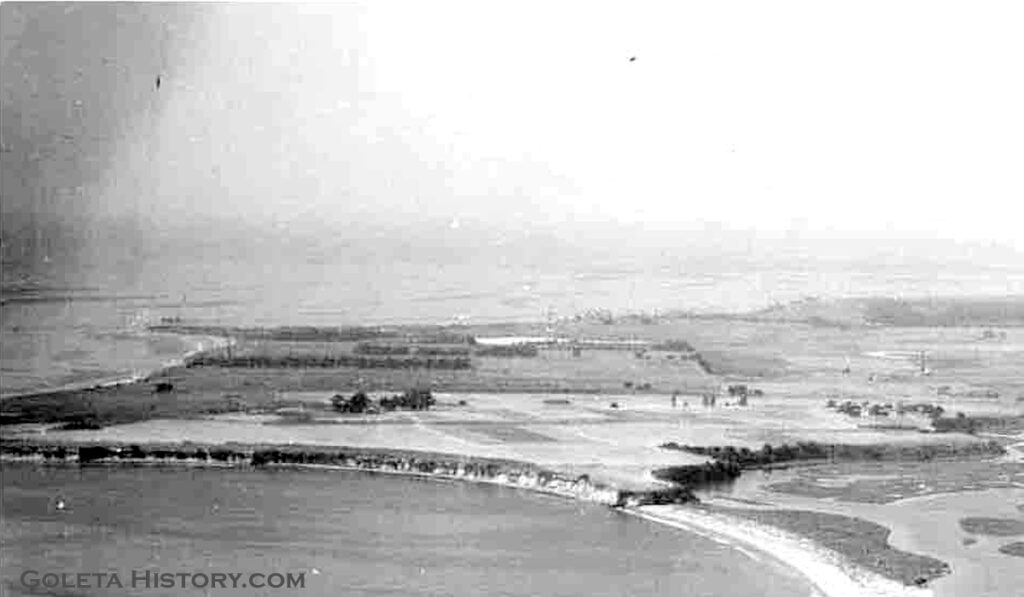
After the asphalt mine closed, the Dens had a treeless, waterless piece of real estate that they didn’t have a lot of value. In 1915, Alfonso Den sold a portion of his property to John and Pauline Ilharreguy from Fillmore. They had a grand scheme for this scenic, but seemingly worthless, piece of oceanfront property. The Ilharreguys paid $100 in gold for 157 acres of barren windswept land on the bluff above the ocean and went to work planning a coastal community that had a gimmick.

In 1910, the state of California produced 77 million barrels of oil. While we don’t know much about the Ilharreguys history, we can assume they knew this fact. They surely also knew that the mesa they were about to buy was right between a former asphalt mine and Coal Oil Point, that was covered with tar.
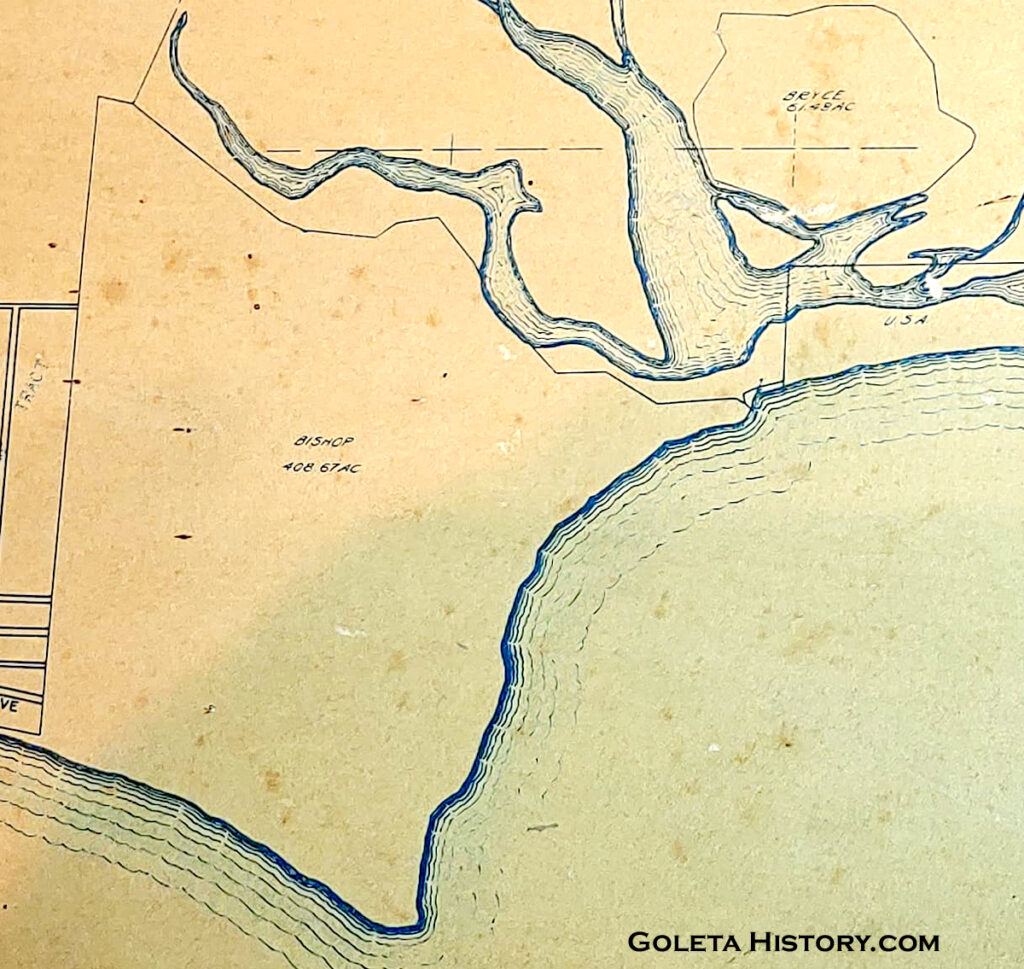
In 1923, Gus Den put his parcel (that had the asphalt mine on it) up for sale with an option to drill for oil first. After one potential buyer opted out we can assume he found no accessible oil. The Bishop Ranch ended up buying the land to expand their already massive operation. But the fact that no oil was found there didn’t discourage the plans of the Ilharreguys.
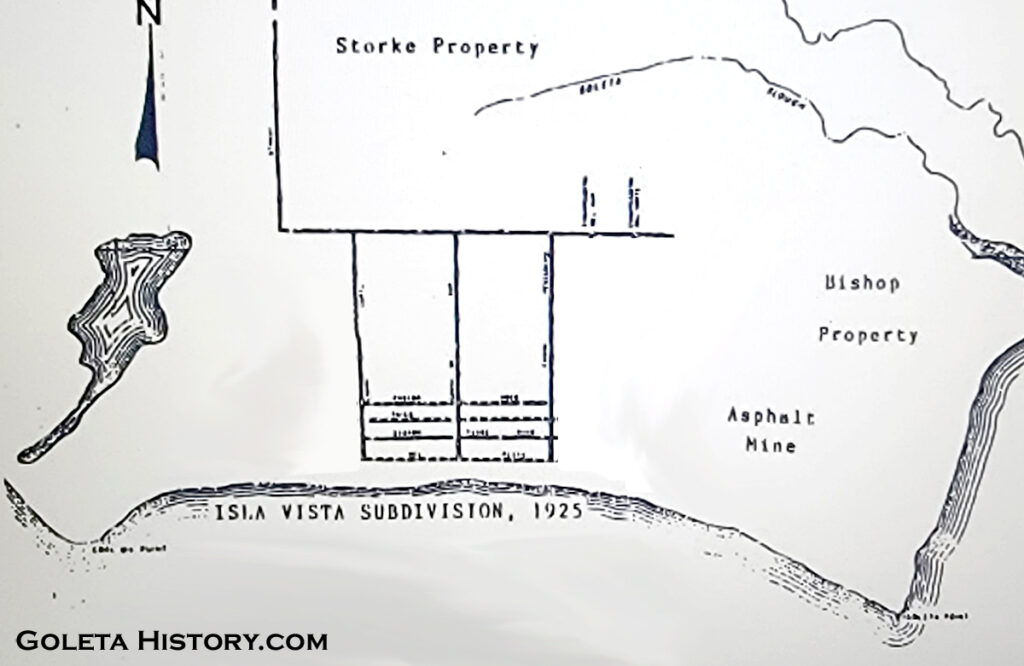
In 1925, the Ilharreguys laid out on paper their new subdivision that they named “Isla Vista”. Their real estate scheme was going to involve living on the scenic coast while enjoying the fortune of the oil industry. They divided the beach front into narrow 25 foot lots, and then the rest of the subdivision had standard 50 X 100 foot lots. They would drill for oil on the smaller lots, and if you owned any lot in the subdivision, you shared in the profits from an oil strike anywhere on the property. The lots were like shares in an investment. The more lots you owned, the greater the percentage of oil profits you would receive. Everyone’s a winner, if oil is found…..
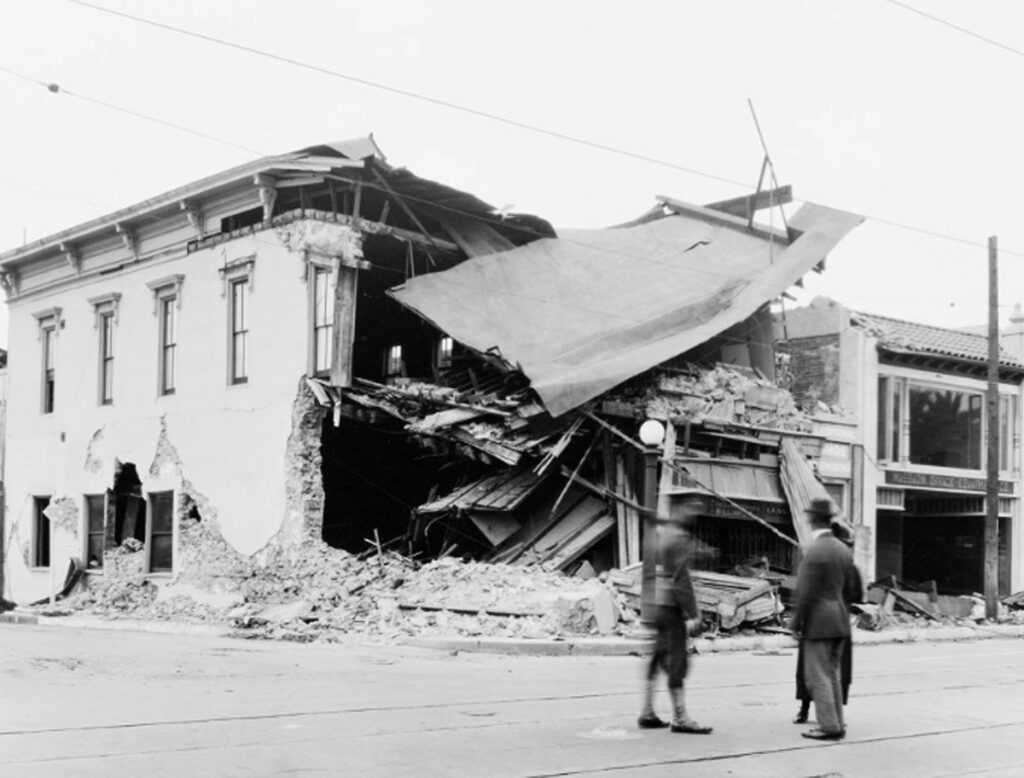
Santa Barbara had just survived the massive earthquake of 1925 and the city leaders decided to rebuild itself in a uniform Spanish Colonial theme. All new developments in the outlying areas followed their lead and the Ilharreguys thought it would be wise to choose Spanish names for their new subdivision as well. Unfortunately, they were clearly not fluent in Spanish, and the names they came up with were proof.
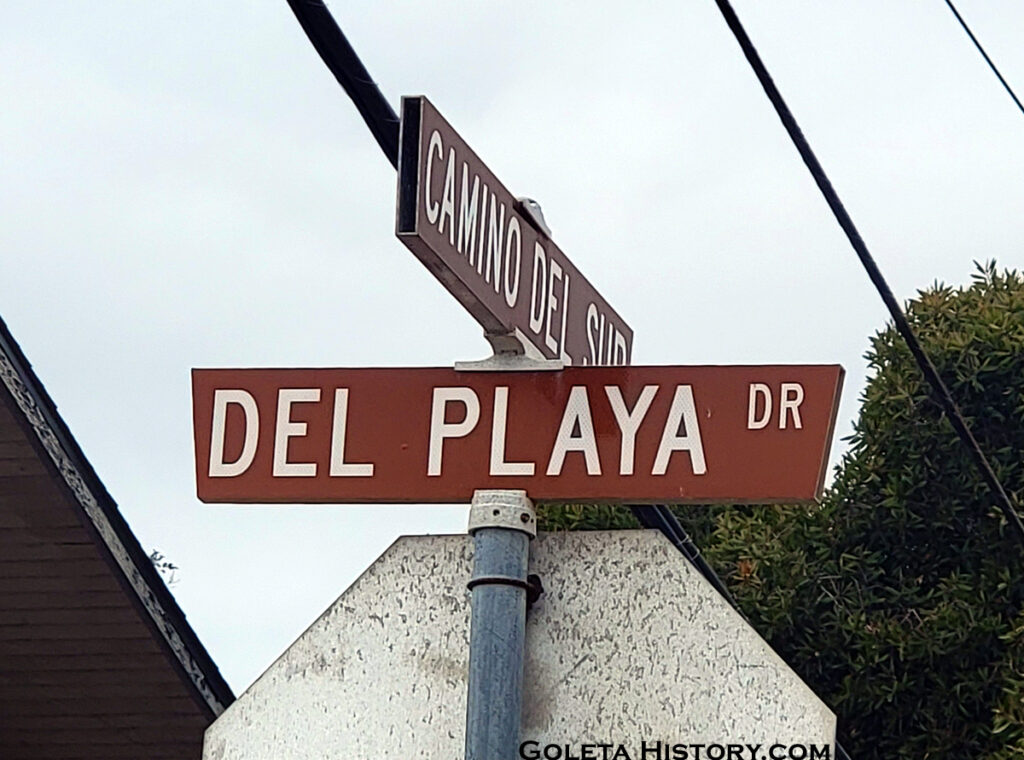
Isla Vista is grammatically incorrect, the premier ocean front road, Del Playa, is also grammatically wrong, and the meaning behind the name Pasado is anyone’s guess. But none of it mattered, the subdivision was quickly and easily approved.
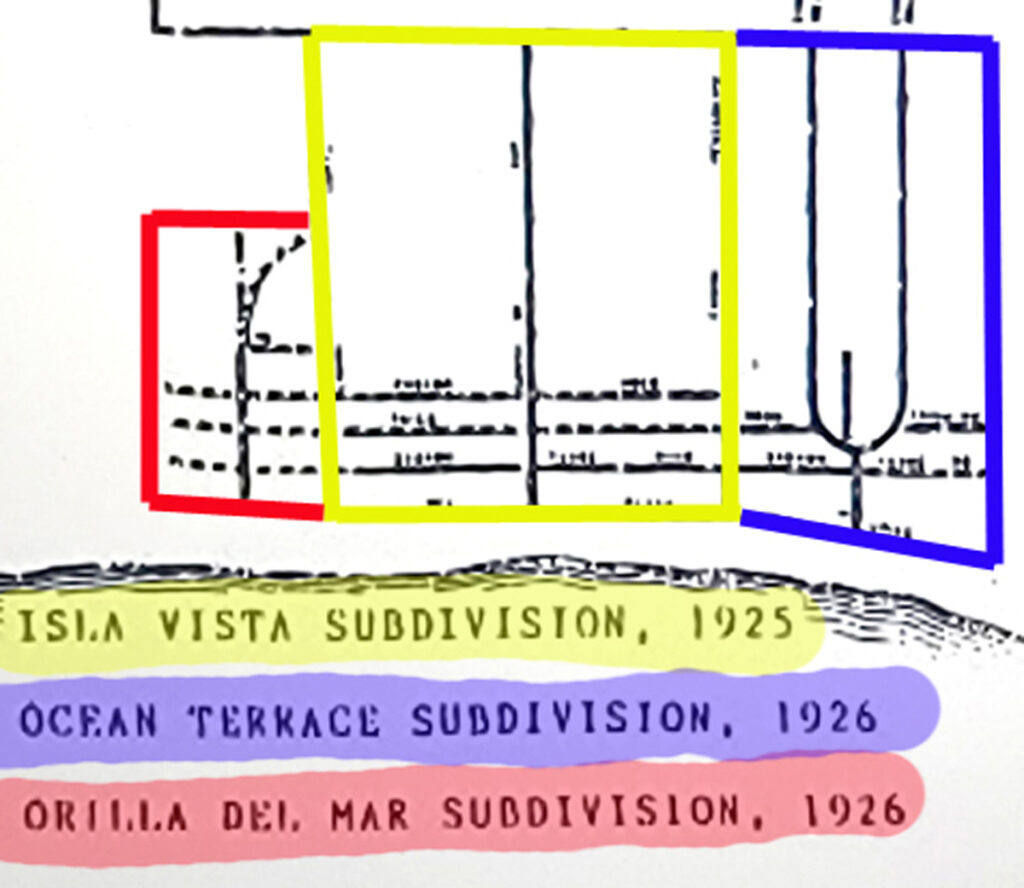
Their unorthodox idea of a wealth sharing neighborhood appealed to other “insiders” that heard about it, and within a year, both sides of Isla Vista were sold and subdivided. Two Santa Barbara lawyers bought the land east of Isla Vista, drew up adjoining streets and copied their narrow beachfront lots. The 2 roads that ran from the access road joined near the ocean making a loop that was to be the location of a park. They also chose Spanish names for all the streets but they gave their neighborhood an English name, Ocean Terrace. Later in 1926, another subdivision was planned to the west of Isla Vista by the Moody sisters, also of Santa Barbara. They both worked for the County and their father was a building contractor. They followed the street pattern but left room for an oceanfront park in between the oil lots. This neighborhood was named Orilla Del Mar, or Seashore. While all these plans looked impressive, only 3 roads actually existed. The rest of this was merely on paper as a real estate promotion, not an actual development.
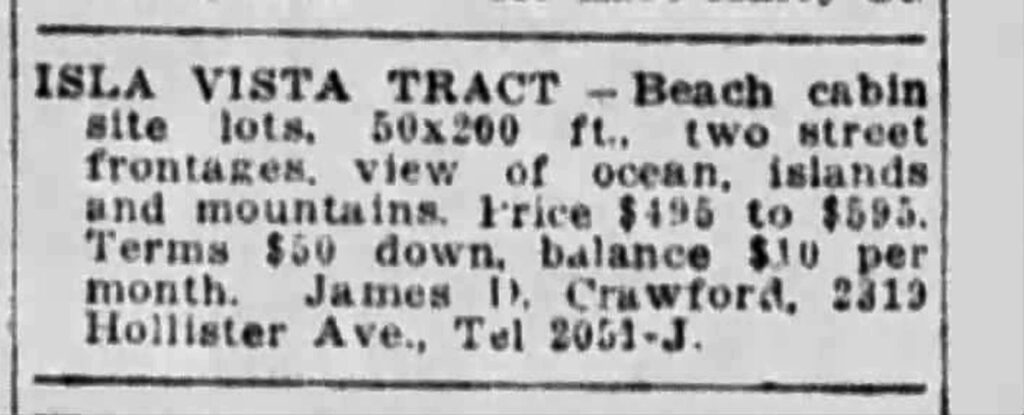

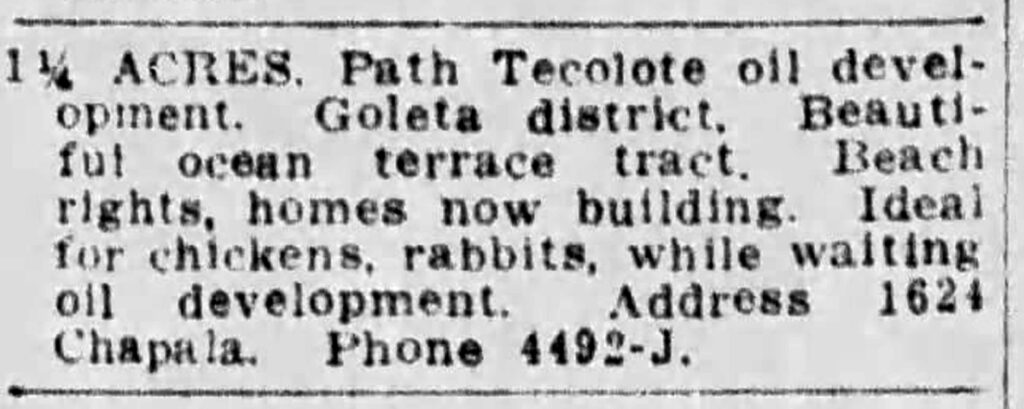

And promote they did! In 1926, the newspaper was full of great deals on real estate on the former Rincon Ranch.
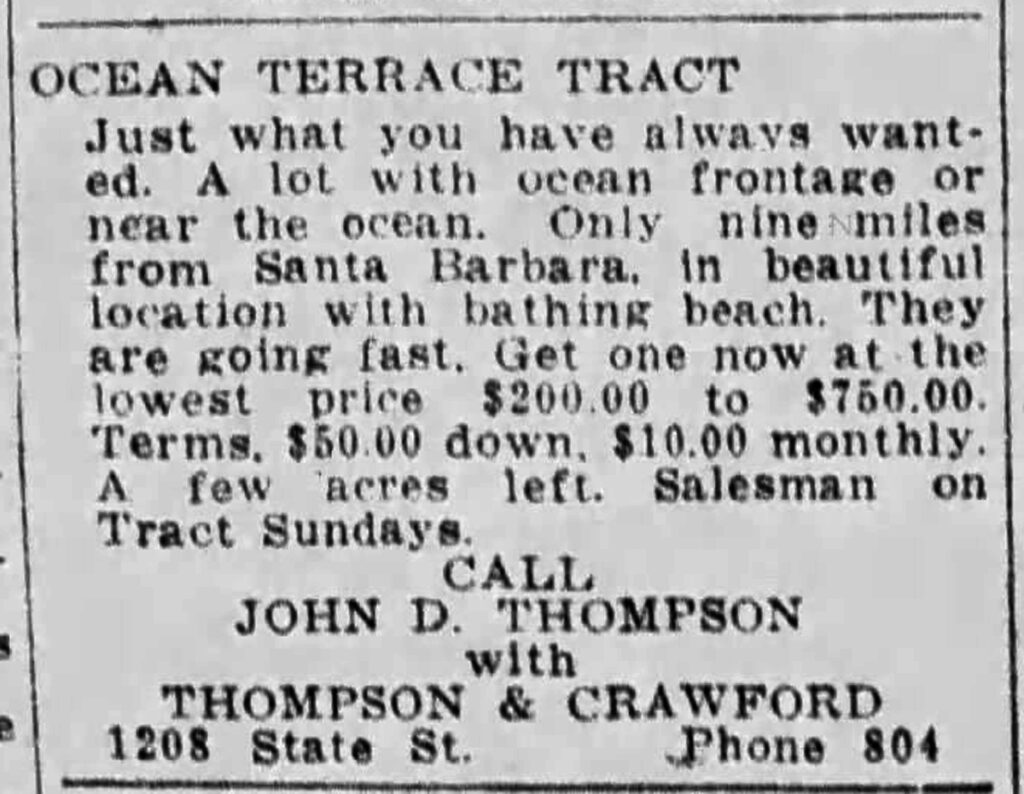
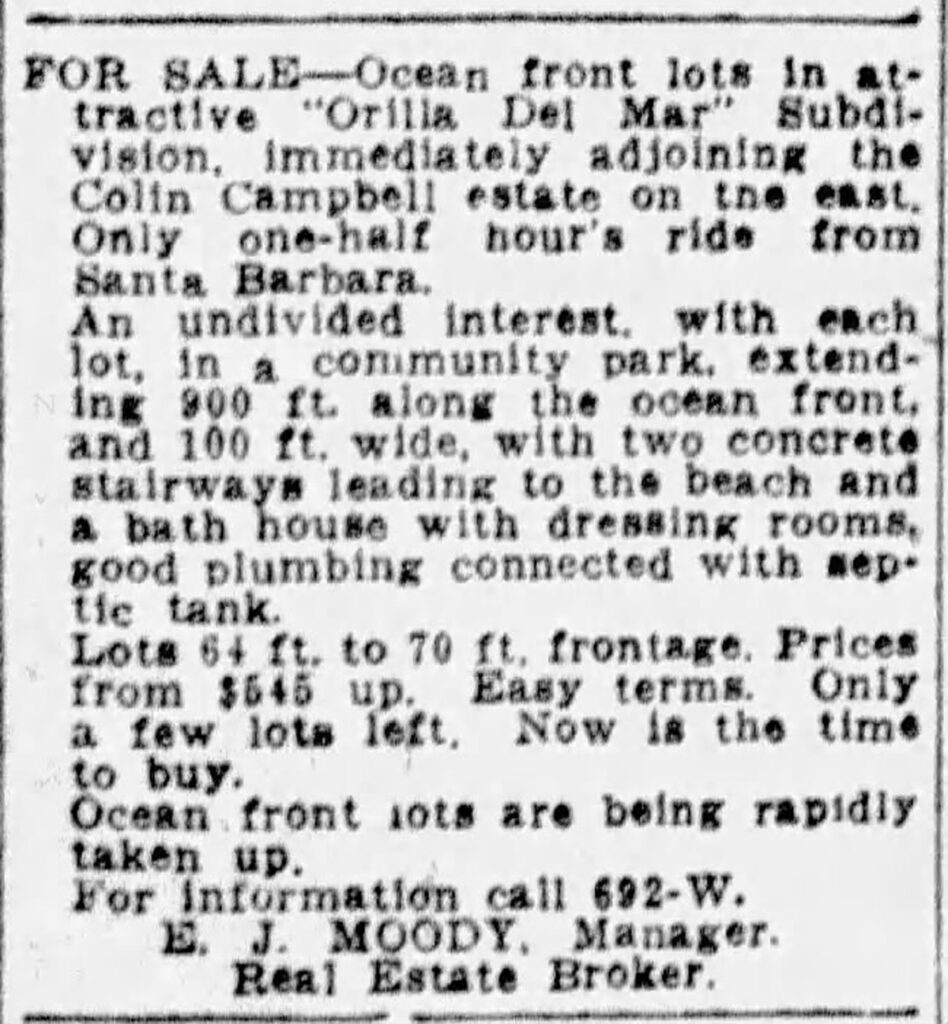
Between 1920 and 1924 about 100,000 people moved to Los Angeles, mostly due to new water availability, the motion picture industry and multiple oil discoveries. This was the start of a decades long boom of growth. The Santa Barbara area also experienced a frenzy of developments and the Isla Vista tracts were right in the mix with local and out of town investors buying and reselling lots. Real estate promotions were nothing more than a plan on paper and a few stakes in the ground. Without potable water and the oil discovery that this promotion was built on, Isla Vista would remain worthless.
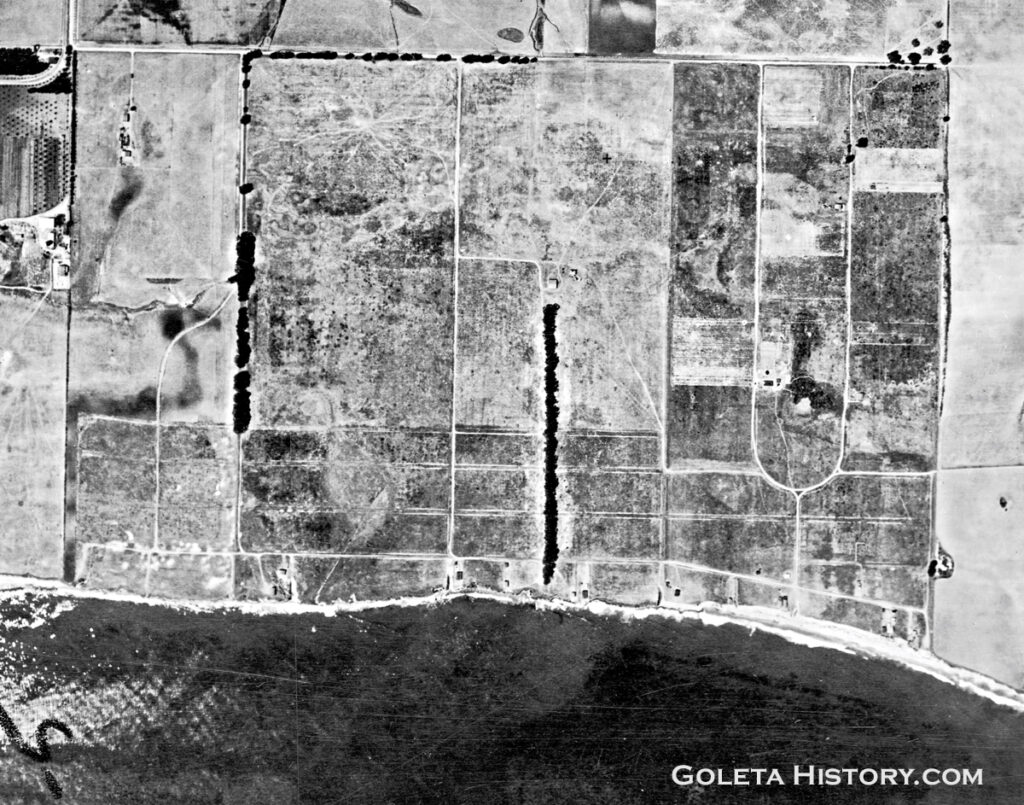
Isla Vista was the first subdivision performed in the Goleta Valley. No plans for water, electricity, road building, or sewage were made, this subdivision was “speculative”. In 1928, Isla Vista looked about the same as it had for decades. Desolate, waterless and empty, except for a couple hardy bean farmers and their chickens and goats. Some roads had been lightly scratched into the hard soil, mainly to allow the delivery of water. While it looked like the dream had seized up, it still existed on paper. It just needed a little oil to get things moving again.
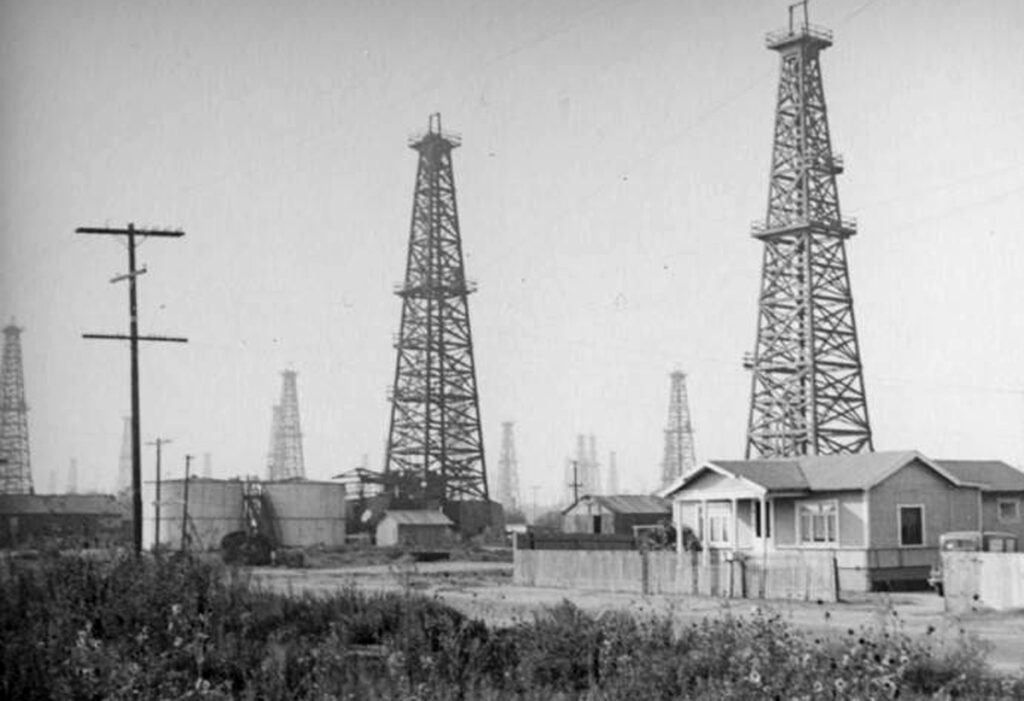
While living next to an oil well sounds horrible to us today, it was not uncommon in Southern California at this time. Since oil played a crucial role in the Isla Vista dream, exploration was encouraged. Throughout the 1930s, several attempts were made by different companies in the Isla Vista area. A few companies found a little oil, but not enough to pursue it any further. The lots that had sold remained undeveloped and some of the lots that didn’t sell had to be deeded to the state to pay off taxes.

This surveyor map from 1935 makes Isla Vista look like a legitimate little community. Plenty of city streets laid out in a nice orderly manner with their fancy Spanishey names on full display. The County never required the three subdivisions to use a common street layout so a few of the streets didn’t quite line up right, but, hey, even beautiful Santa Barbara has that problem!
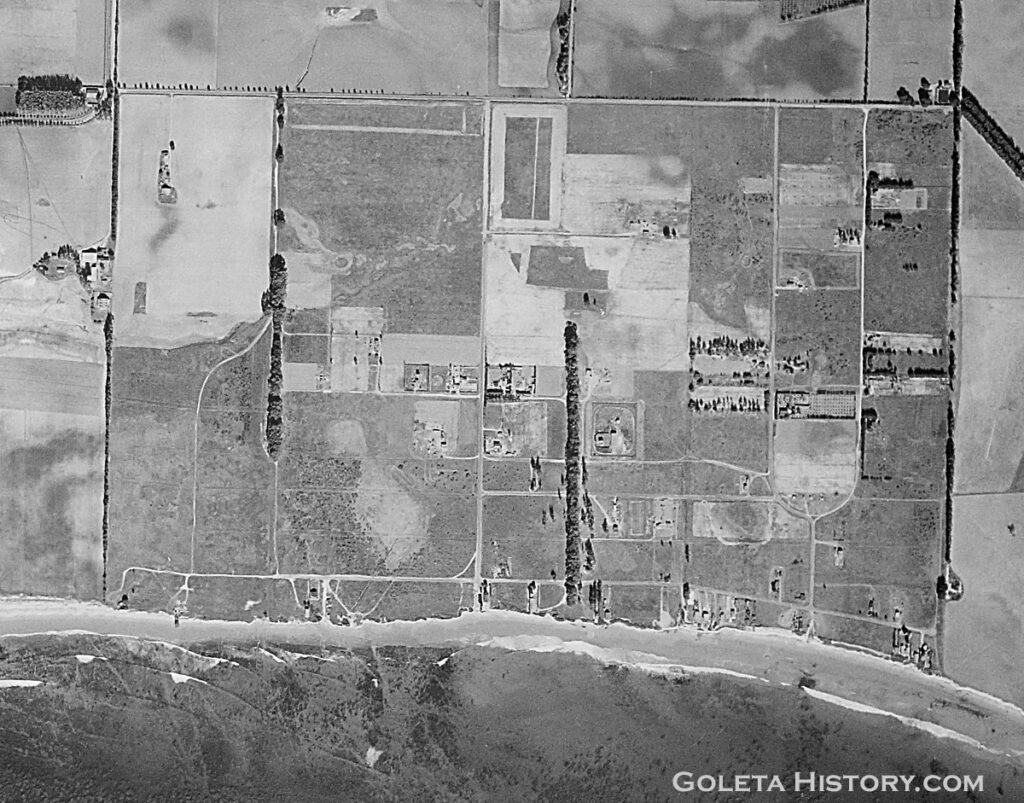
This shot from 1938 shows what Isla Vista really looked like. A few of the subdivision roads actually existed, mixed with a mish mash of trails, shortcuts and pastures. And watch your step, no sewer system existed so sewage and garbage were disposed of in a variety of ineffective manners.
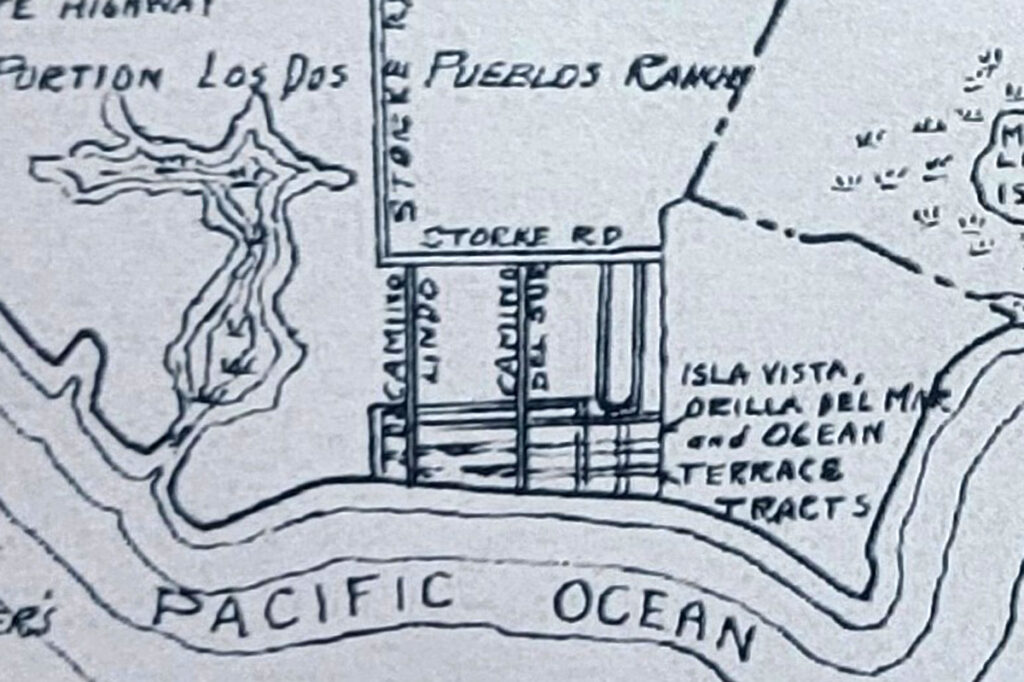
This 1939 map drawn by Owen O’Neil shows a more realistic appraisal of the Isla Vista area. He mentions all three development names, but only a couple street names are noted and the old Rincon Ranch road is labeled Storke road.
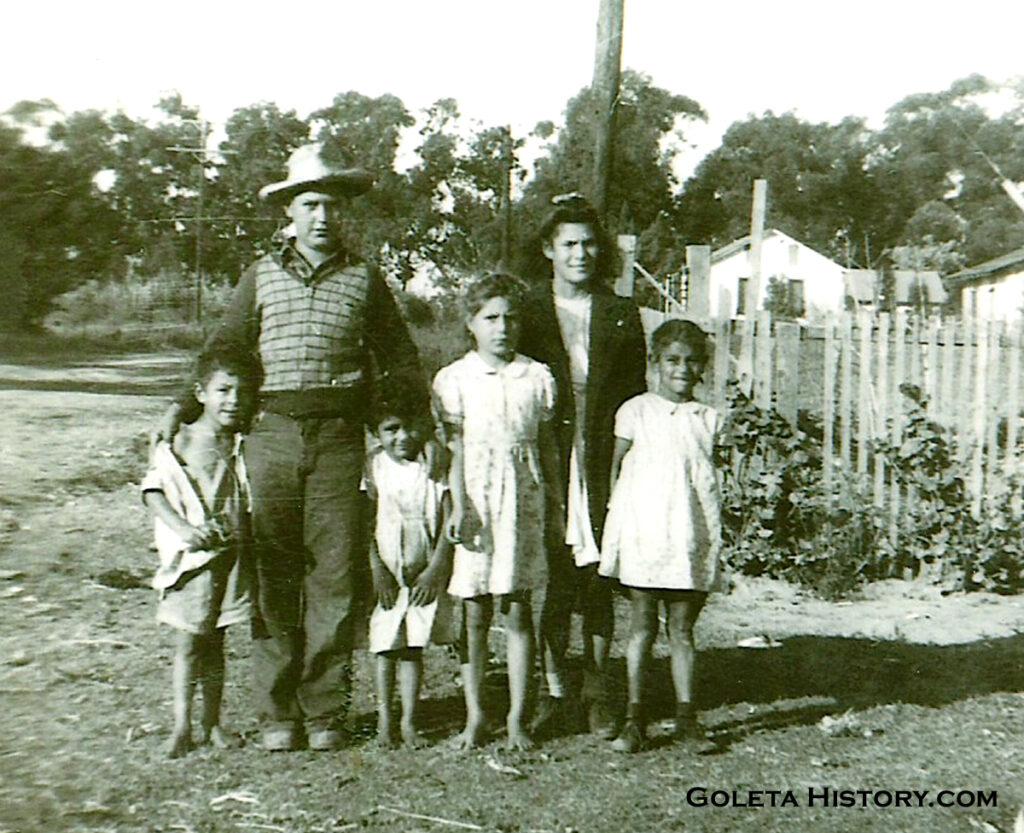
Meanwhile, despite all the investors struggles and the lack of modern conveniences, a few families managed to live happily on the undeveloped subdivisions. This 1942 photograph labeled “Ocean Terrace”, shows young members of the Munoz and Cuevas families enjoying the freedom that wide open spaces can bring to a child. But the Eucalyptus Curtain behind them concealed a world of change that was about to come in their direction. The United States had gotten into World War II and a new Marine base was being constructed as fast as humanly possible.
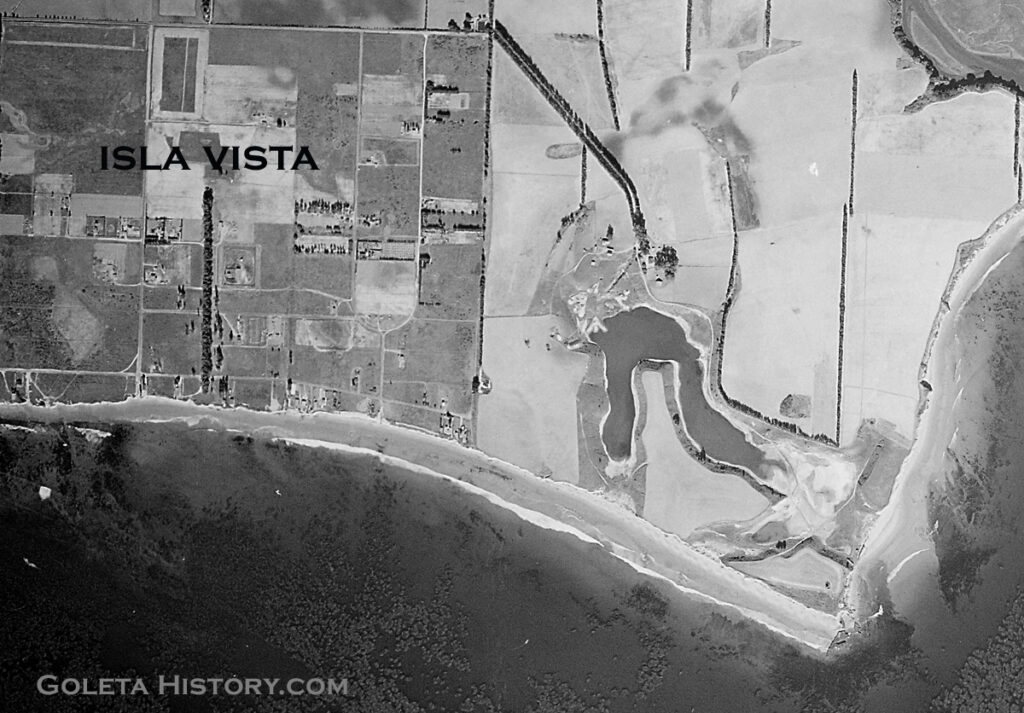
In 1938, the property to the east of Isla Vista was a huge expanse of barren land looking for a purpose. The war brought that purpose.
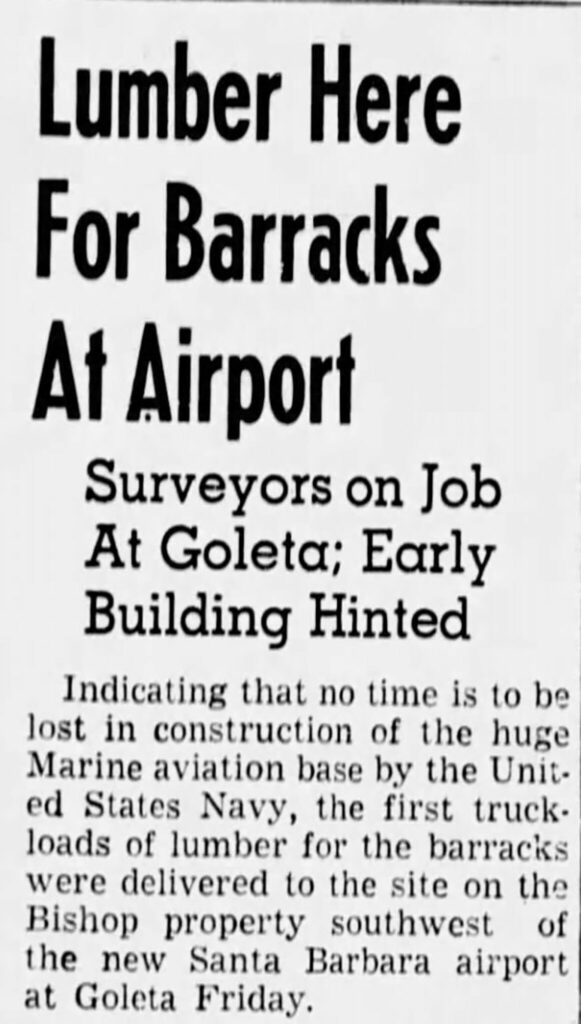
The swift construction of a Marine base turned a treeless, waterless property into a valuable asset.
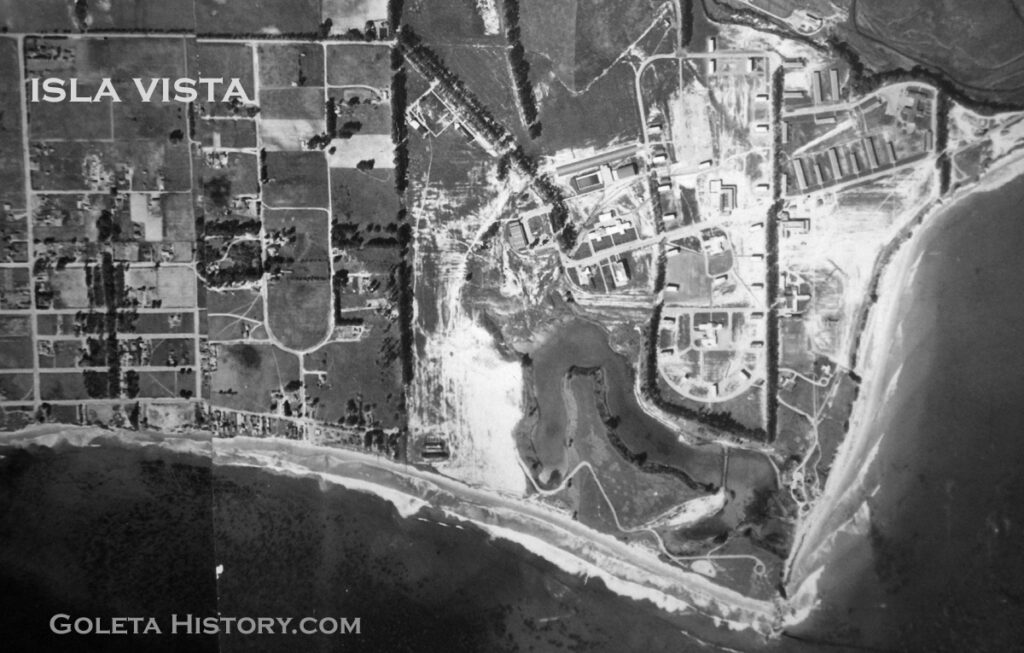
By 1943 that barren land was the site of a small city, quickly built just for the United States Marines. Over 100 wooden buildings including barracks, mess halls, chapels, theaters, laundry, administration and other facilities were all built on the empty mesa. But the new base next door didn’t change anything in Isla Vista, other than an unofficial horse stable a few officers bought to enjoy horseback riding in their downtime.
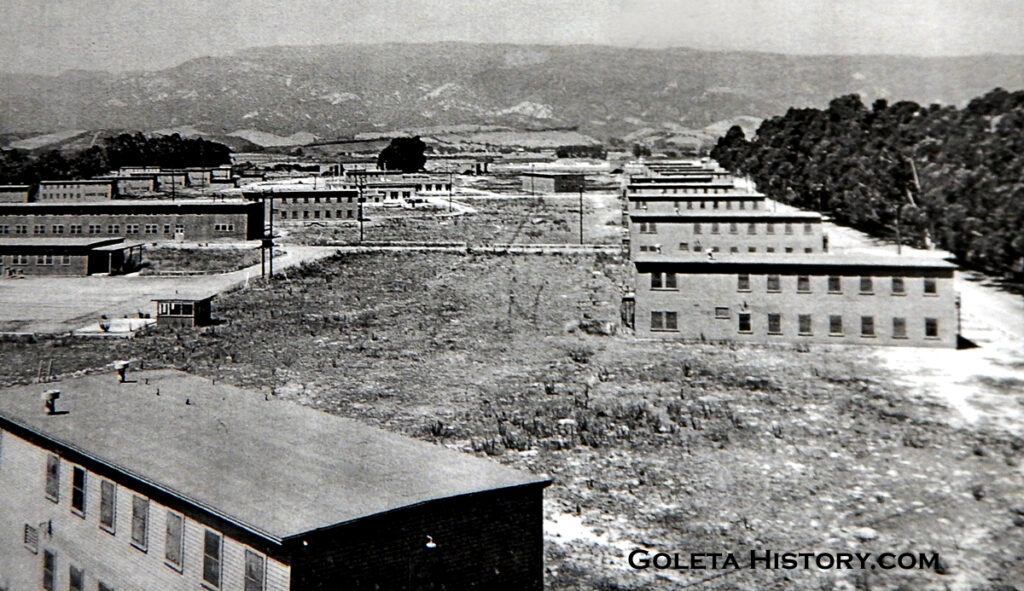
After the war ended, the Marine base was closed down. The Bishop Ranch didn’t want the land back, so it was set to be sold on the open market. While the Marines time in Goleta didn’t directly affect Isla Vista, the next occupant certainly would.

Thomas Storke and a group of his influential friends were able to persuade the government to sell the whole area to the University of California for $1. They took over the real estate and the now abandoned buildings with plans for a beautiful new UCSB campus that would have plenty of room to grow. The hard won decision to move the college from its Riviera location to Goleta was criticized by some, saying it was moving, “the campus with a view, to the campus in the slough”.

While all the wheeling and dealing for the University was going on, property owners in Isla Vista kept busy trying to finally cash in on their investment. A couple more oil companies tried again to find oil using new and improved technology to drill deeper down than ever before. While they did find minimal success, it still wasn’t worth the effort, and the oil companies lost millions of dollars. Now it seemed the Ilharreguys’ dream of an oil rich community was officially dead. But some good news came in 1949 when the Cachuma Dam project was approved, promising access to water in the near future. Running water and being located next to a new University would be very good fortune for Isla Vista property owners.
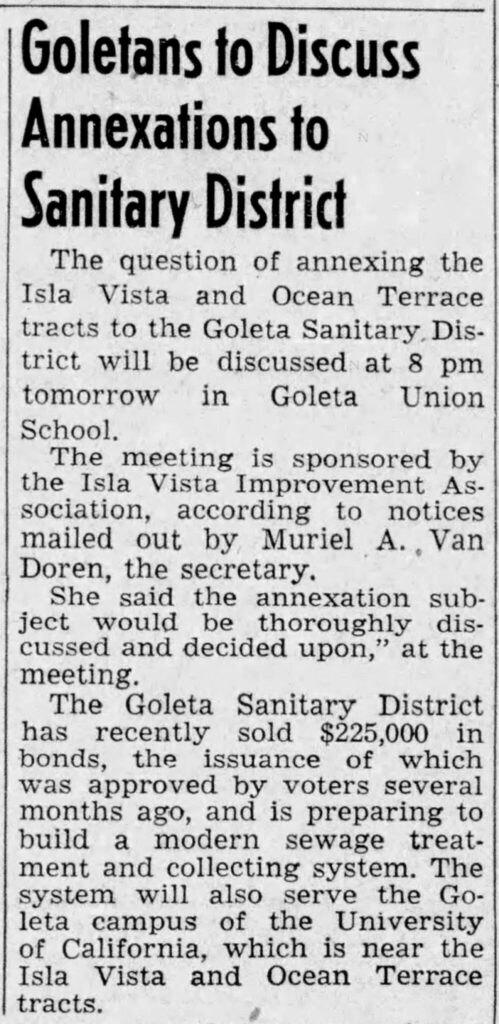
With news of the university becoming official, property owners formed the “Isla Vista Improvement Association” and began petitioning officials to get a sewer system in place. The first influence their new neighbor had was a positive one since UCSB was a powerful ally for getting the mesa hooked up to much needed utilities. But the narrow streets that didn’t line up and the undersized lots laid out for the 1920s oil scheme would come back to haunt the planners.
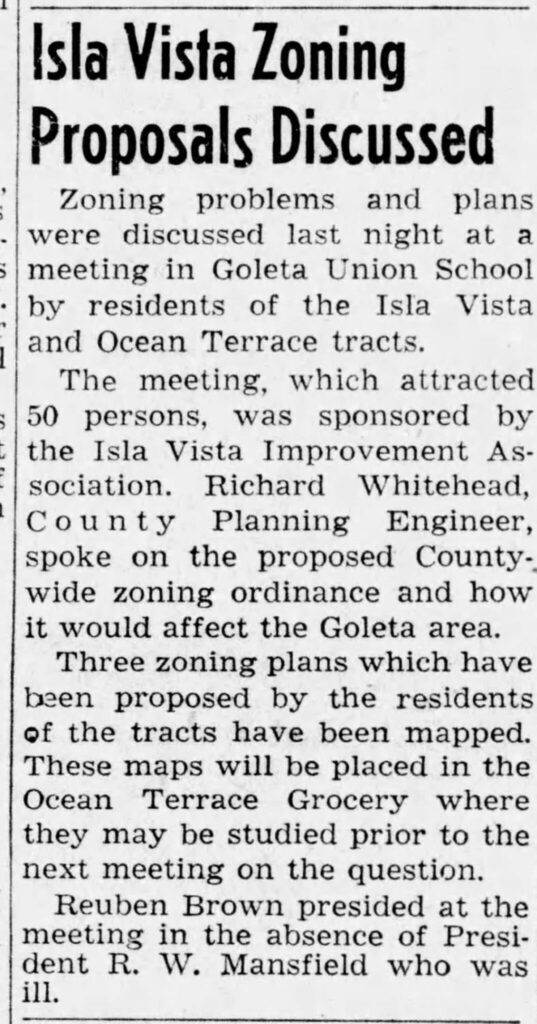
Before Isla Vista could become a community, it needed zoning. With the university coming to the area, county officials now realized they had to deal with this ramshackle little community that had always been overlooked. The County Planning Director saw the narrow streets and tiny lots and determined low density would be best there. But the property owners saw things differently. Remember, this was an investment community born of the desire to make a profit. The 330 acres of Isla Vista were owned by 500 individuals, most of them lived out of town and they wanted a long awaited return on their investment. Surprisingly, the majority of the owners that actually lived there also wanted to maximize their profit! They all seemed to agree, if they couldn’t get rich from oil, they would get rich by maximizing the value of their land. Higher density meant higher land value so they pushed the County for as much multiple residential zoning as possible.

After multiple meetings, a zoning map was finally finished. About half of Isla Vista was zoned multiple residential allowing 4 or more units each lot, the loop on “Ocean Terrace” was zoned commercial, and the rest was all zoned for one duplex per lot, including the tiny beachfront lots. So every property owner could build a duplex and be a landlord. At max capacity, Isla Vista could house 13,000 people in a half square mile, 43 folks per acre. More density than anywhere west of the Mississippi at that time. Surprisingly, the county was fine with that, but they did insist the roads be widened. 500 property owners were persuaded to donate 10 feet of street side property to the county and the roads were widened.
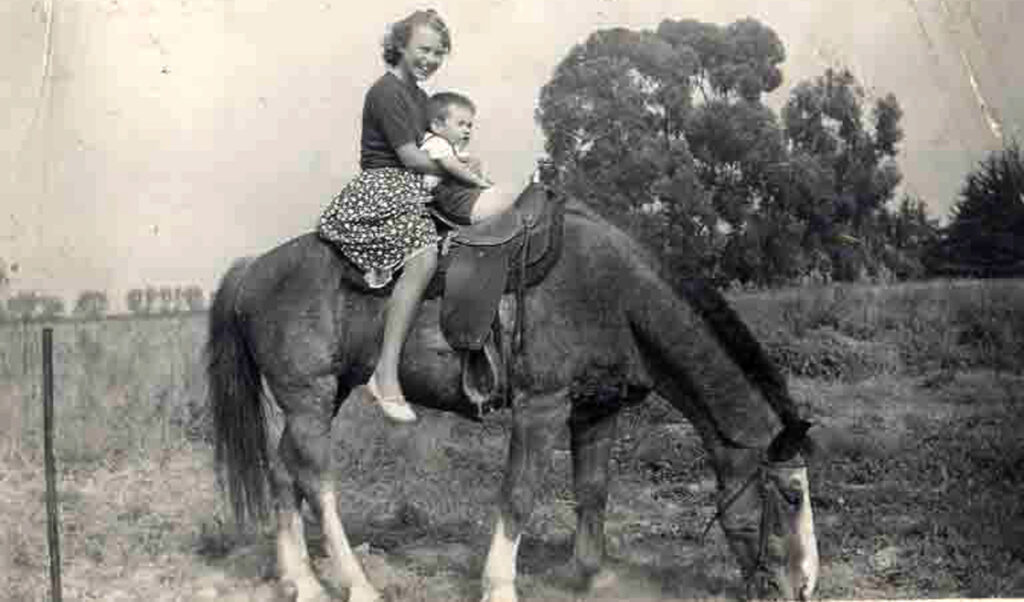
While progress was being made on paper, an actual site visit by the County Health Department in 1953 proved the community had a long way to go. The roads were soft dirt, the majority of the housing was sub-standard, nearly all were using bottled water and nearly half the homes had outhouses for toilets.
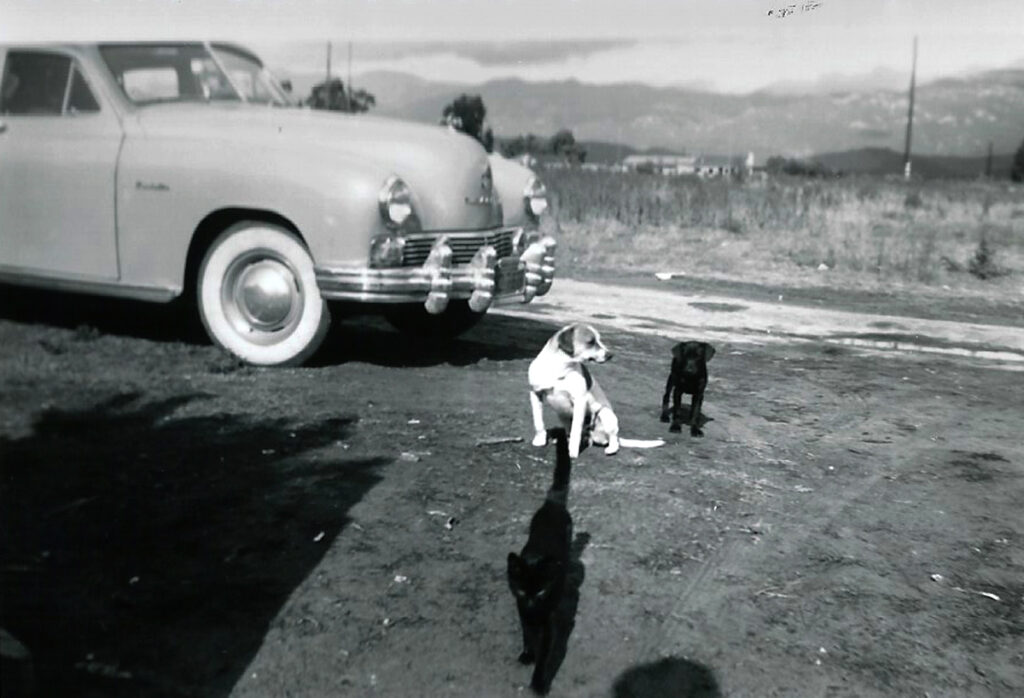
A majority of the residents had livestock, (over 1,000 animals, not counting dogs and cats!) and garbage was either burned, buried or fed to the animals, resulting in garbage piles all around. This would not do for the neighboring community of a big university.
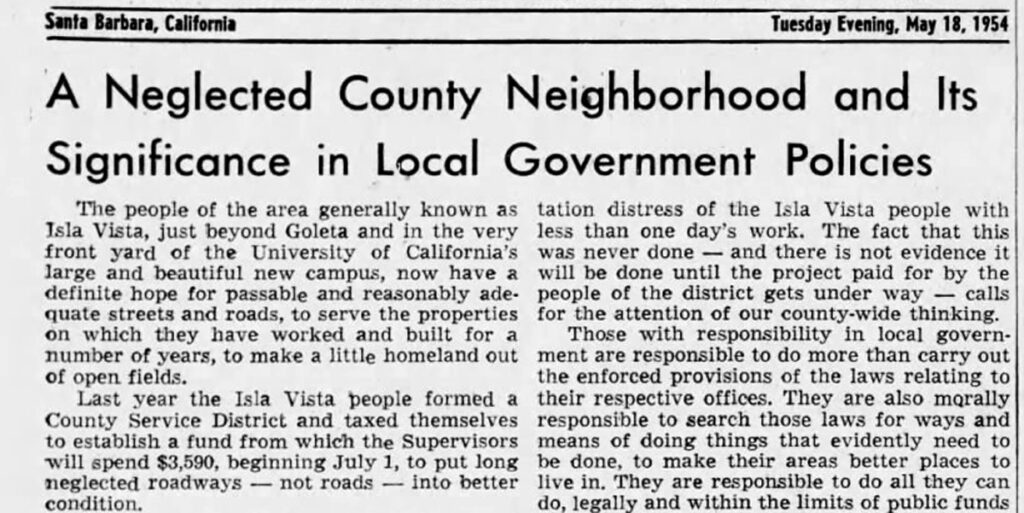
But the citizens of Isla Vista willingly taxed themselves and found a way to get their community in order. Tom Storke wrote an editorial in his News Press, praising their efforts and scolding the county for not being more helpful. Storke was surely concerned about Isla Vista getting modernized, since his new location for the university was called the “most isolated college in higher education”. In fact, for the first few years after the campus opened in 1954, most of the students still lived in Santa Barbara.

Throughout the late 1950s, the student population increased and new buildings were quickly built on campus. Meanwhile, Isla Vista was working hard to get their act together. A sewer system was finally installed, old shacks were being demolished and properties were being cleaned up. Some property owners wanted to move old houses from Santa Barbara to their Isla Vista lots, but most residents protested against that and the university agreed. UCSB requested that the county monitor all the development on the perimeter of the campus, so the county passed a design regulation to cover all of Isla Vista. But the county also allowed exceptions to most every request on lot density to allow for much needed university housing. This would become a trend that could not be reversed.
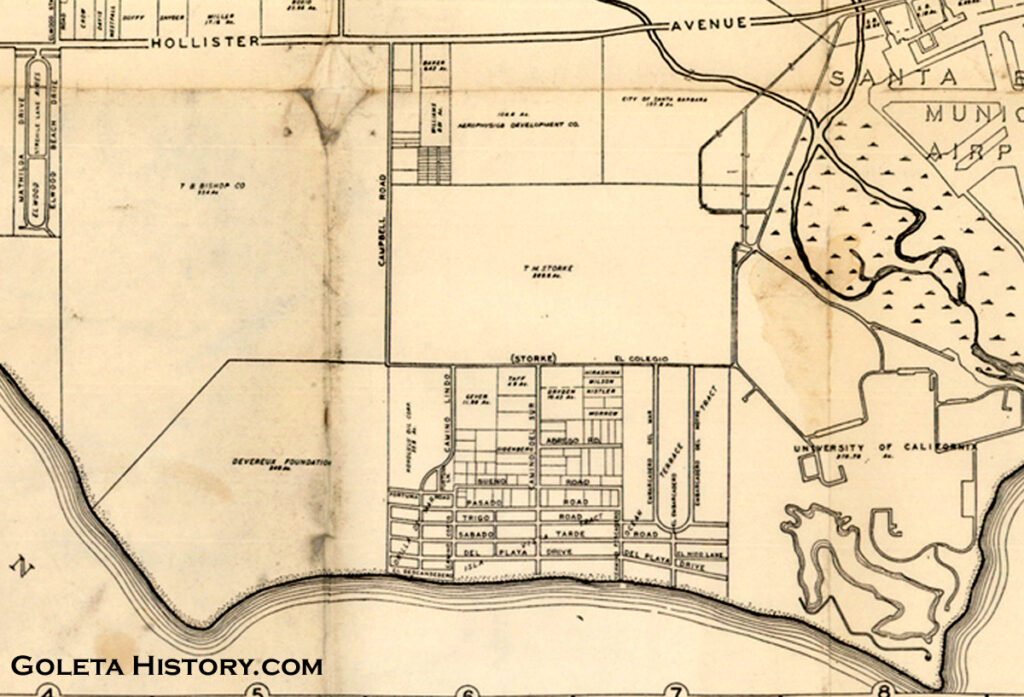
The tireless efforts of the Isla Vista property owners was beginning to pay off and property values skyrocketed. The entrance road name was officially changed to El Colegio Road. By the late 1950s, even UCSB couldn’t afford the land to build a fraternity and sorority row, leaving them to fend for themselves in Isla Vista. This would cause problems for future residents that had to live next door to the Greek houses.
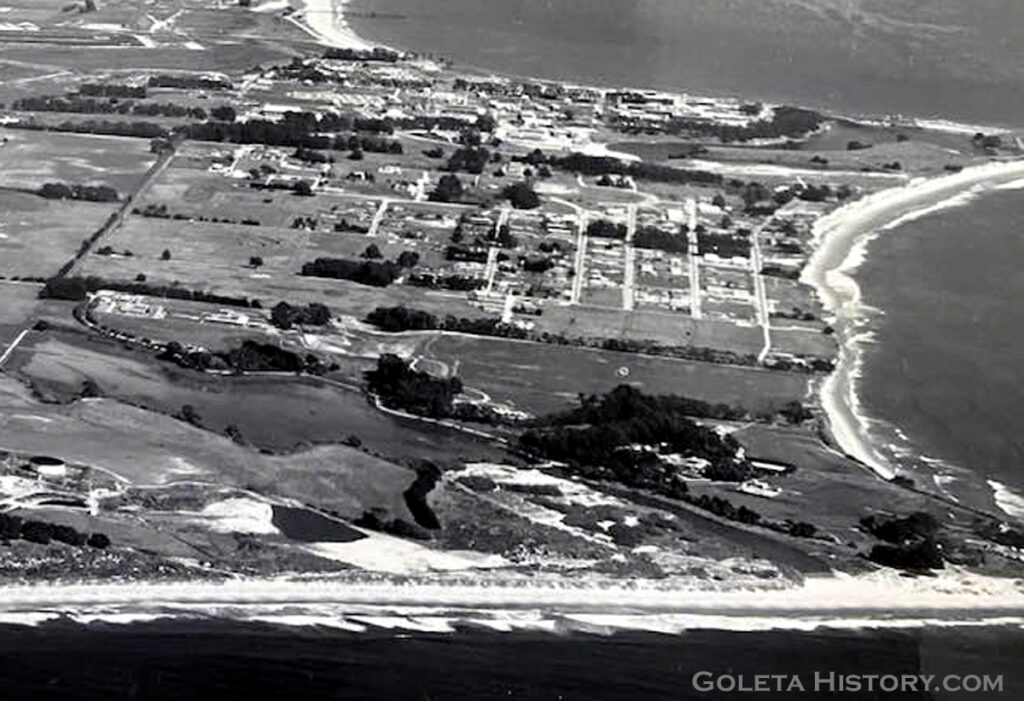
1959

UCSB has had a housing problem since the day it opened. In 1954, very little housing existed in Isla Vista and even the whole Goleta Valley. As the enrollment increased, the housing could never keep up. When there was a housing boom in Goleta in the late 1950s, the majority of those were filled with employees of the new research and development companies opening in Goleta. To make matters worse, the UC Regents announced they were increasing enrollment of UCSB to 10,000 students.
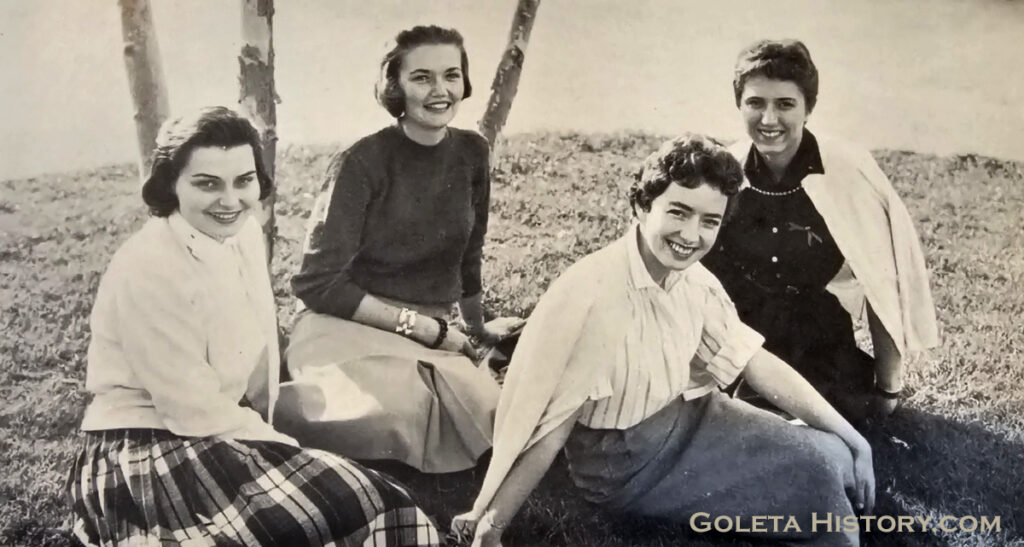
The university came under fire for not providing safe housing for its female students. Multiple male students could pile into small houses or apartments, but the college was held accountable for the safety and supervision of the female students. To remedy this, the Dean of Students recruited a reputable Los Angeles developer to build some apartment buildings specifically for female students. The Tropicana Gardens, Fountainbleu and Westgate apartments were opened specifically for females with security entrances, pools, cafeterias and even a beauty parlor.

Around this time the university also hired a reputable architectural and planning firm from L.A. to help formulate a future housing plan. The “Santa Barbara Campus Community Study” took a year to complete, and when it was unveiled it proposed a stadium, a golf course and turning the slough into a small boat harbor. Isla Vista however, still presented a problem, even to these highly acclaimed experts. With the over 500 separate land owners, poorly designed streets, expensive utilities and high taxes, the expert suggestion was to designate it an “Urban Renewal District”, bulldoze it and start from scratch.
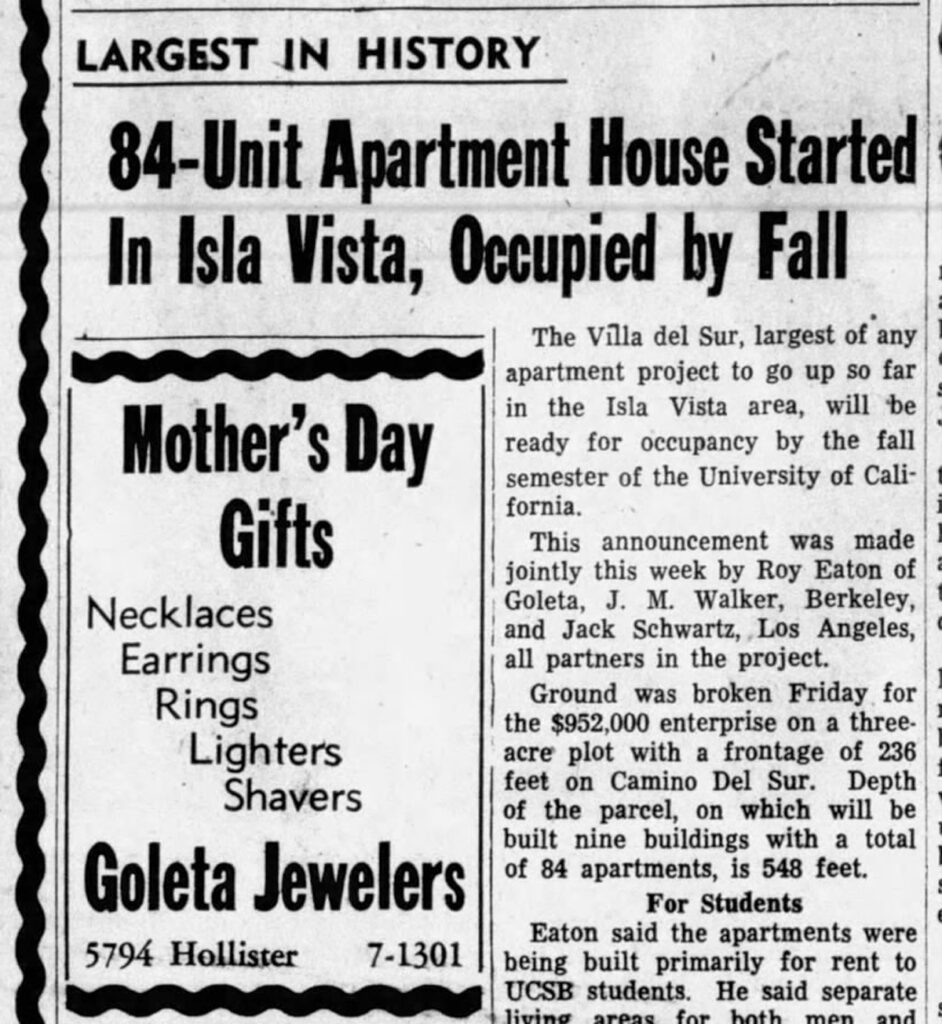
But it was too late for that. The door had been opened for less reputable and more aggressive developers to come in. Before long, apartment buildings were popping up and the overwhelming demand for more student housing forced the county to agree to only one parking space per unit.
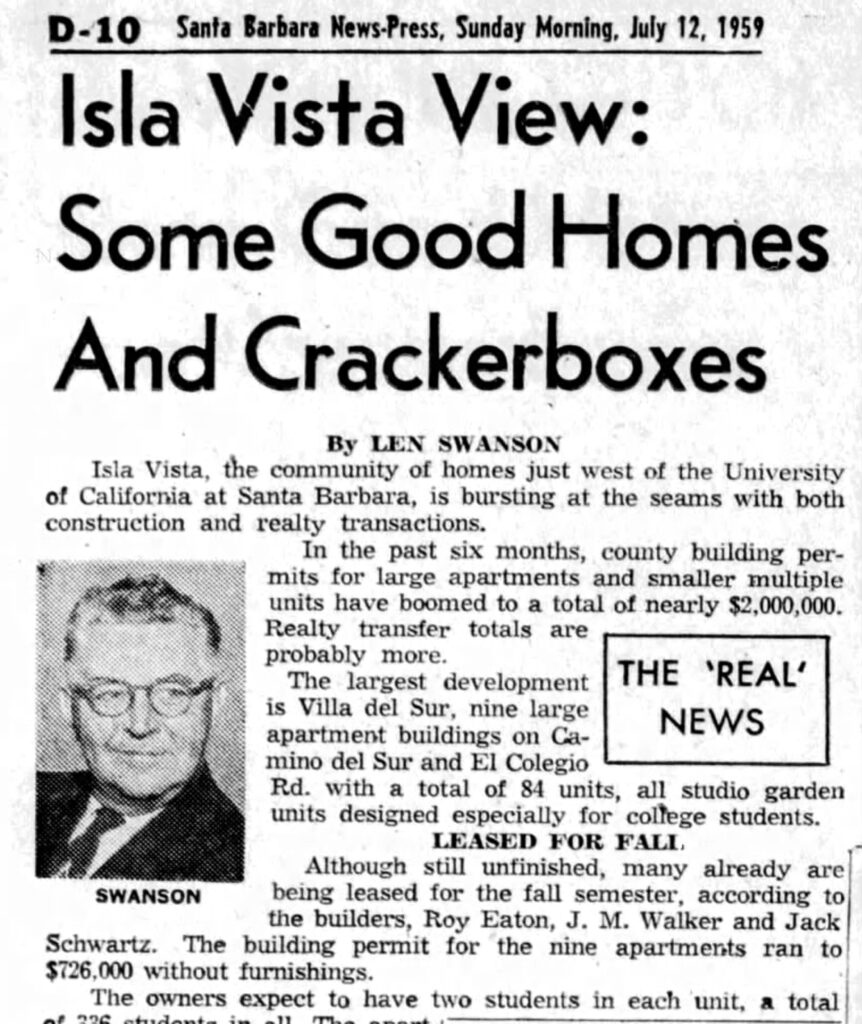
An article written by a popular real estate columnist in 1959 pointed out how Isla Vista was an unplanned “hodge-podge”, full of developers out to make a quick buck building “cracker boxes” with no style. The dream of Isla Vista becoming a charming seaside community was drifting further out to sea.
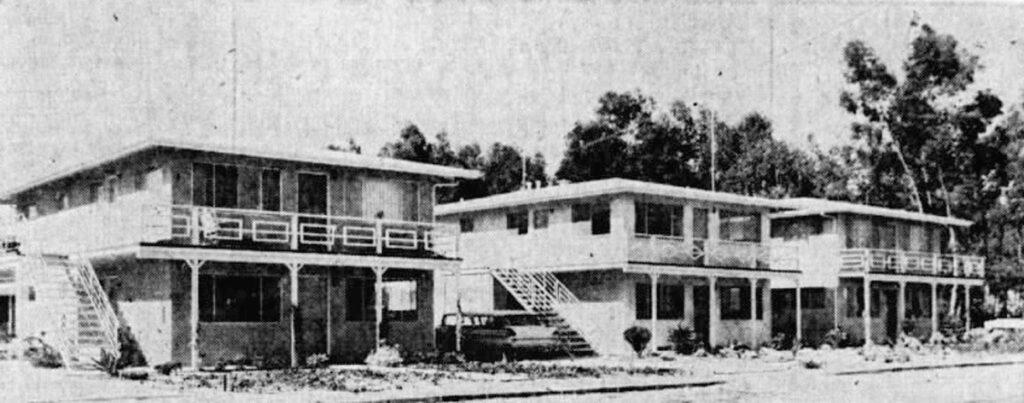
The 1960s brought more of the same. Aggressive developers from out of town had joined the Isla Vista Improvement Association and they had a dominating influence on the planning. Jack Schwartz was the most prominent developer and he led the others with “bulldog tactics”.

By 1967, Schwartz was instrumental in the approval of a new ordinance for the already overpacked neighborhood. An “S” designation for student housing would further reduce the parking requirement for new developments to less then one space per unit! An obviously bad decision that would haunt the community forever.
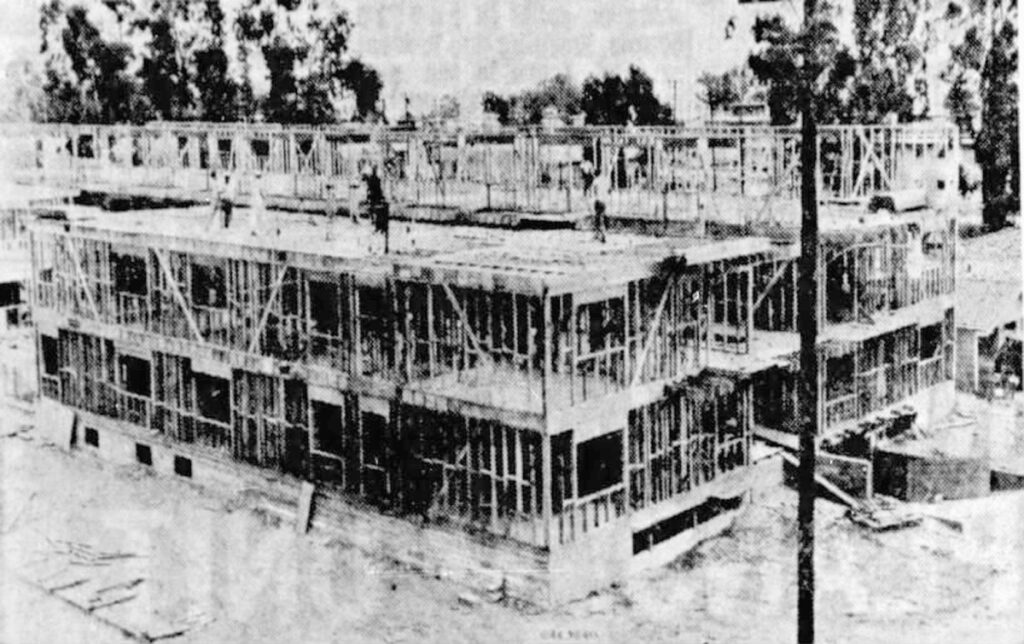
Schwartz also led the charge to change duplex zoned parcels to multiple unit zoning. One realtor that specialized in Isla Vista sales was quoted as saying, “We’ll build until we run out of room. Then it will go to high rise apartments.” He wasn’t wrong.
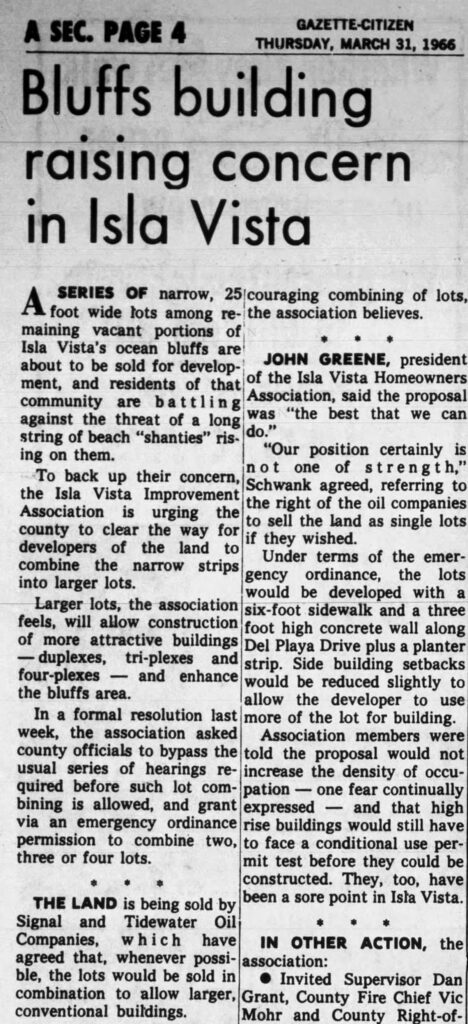
Those tiny little blufftop lots the Ilharreguys had laid out for oil wells were sold in groups to make them big enough to build apartment buildings on them. The concern mentioned in this article should have been for the constantly deteriorating cliffs and the danger of building in such close proximity to them.
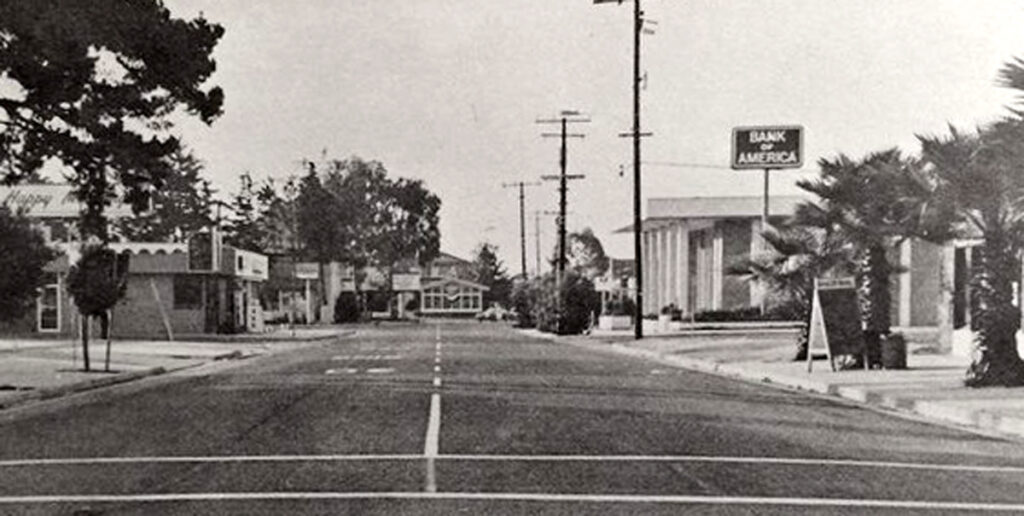
Meanwhile, the commercially zoned property around the Embarcadero Loop failed to develop in an orderly fashion and was also a random hodge-podge of style and uses.
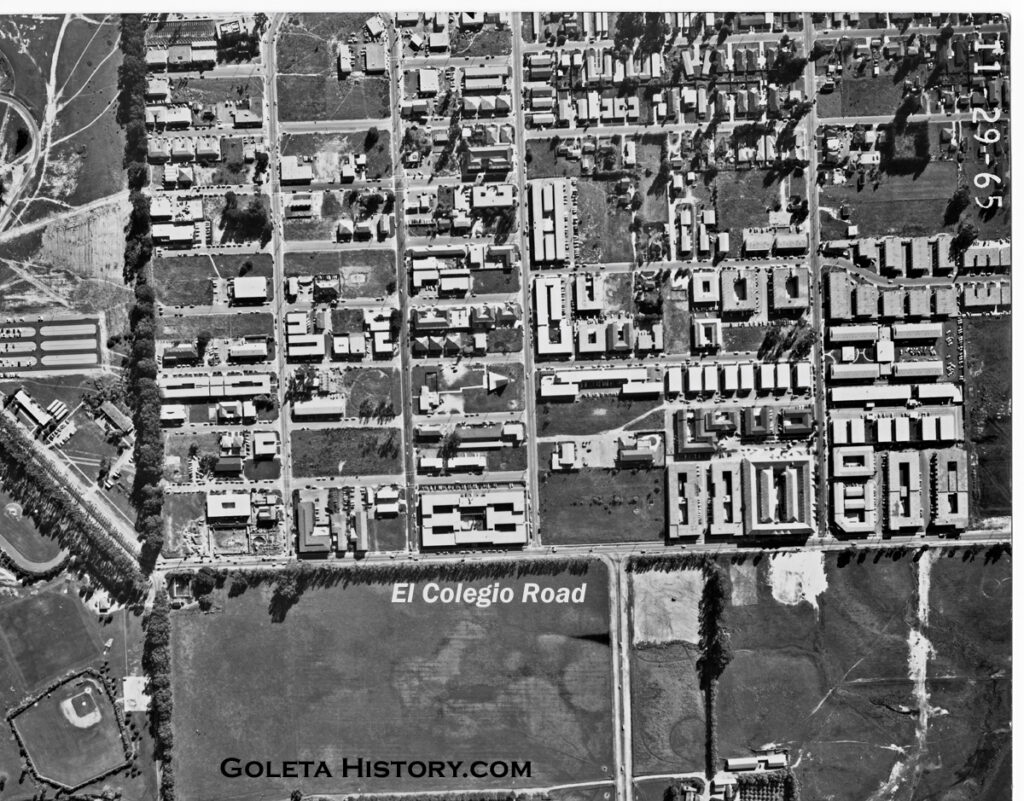
This 1965 image shows there were still more vacant lots to be built on. A volatile combination of greed and power was building this little village by the sea. The university and it’s unending desire to enroll more and more students and the developers that were eager to provide that housing for the ever increasing population. Meanwhile, a tidal wave of social change was about to break on Isla Vista.
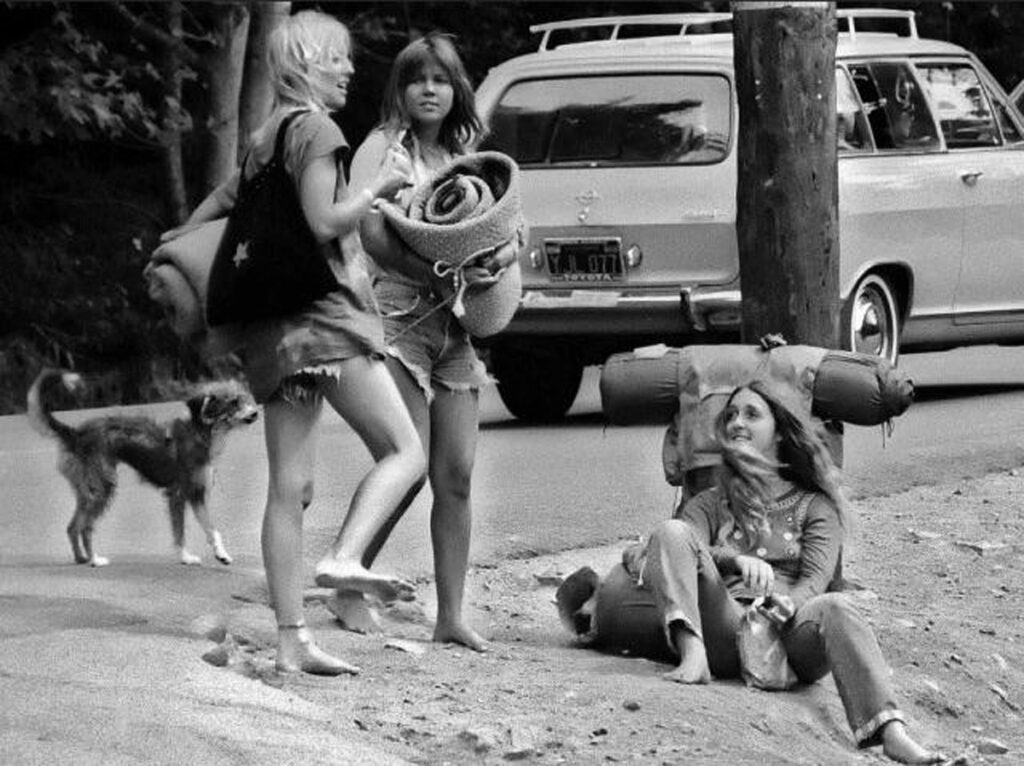
By the mid 1960s California was a boiling pot of youth culture. Isla Vista became a natural stopping point for hitchhikers that were traveling between Southern California and San Francisco. It’s beautiful location by the beach, lack of oversight, and booming population of young likeminded people made I.V. a groovy destination for hippies. A great place to “Turn on, tune in, and drop out”. Local folklore says that Jim Morrison of The Doors wrote the song “The Crystal Ship” while tripping on acid and staring at the bright lights of platform Holly, just off the Isla Vista coast.
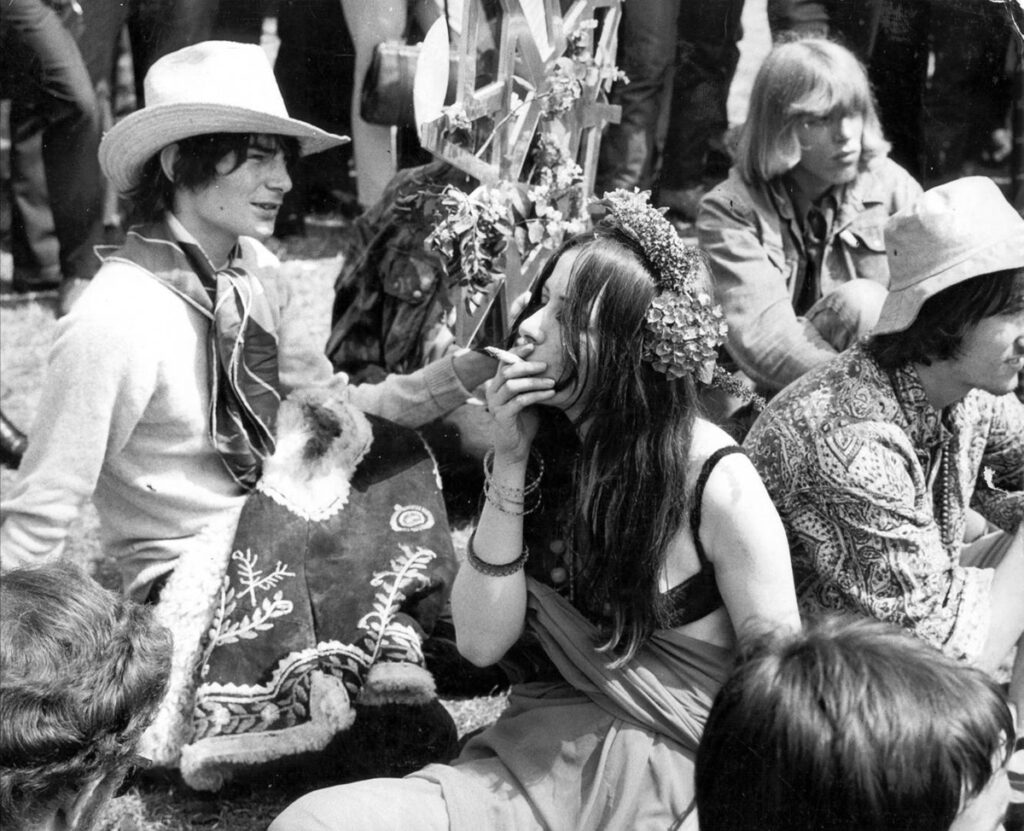
Due to the close proximity of a major university, some big name counterculture speakers came to the coffee houses and parks of Isla Vista, attracting large crowds of energized youth. The Vietnam War, the mandatory draft, the sexual revolution, the civil rights movement, experimental music and experimental drug use were all factors that contributed to the social climate in the overcrowded little beach town. Folks in Santa Barbara and Goleta became uncomfortable with all the open drug use and drug dealing, so a heavy police presence began appearing in I.V.
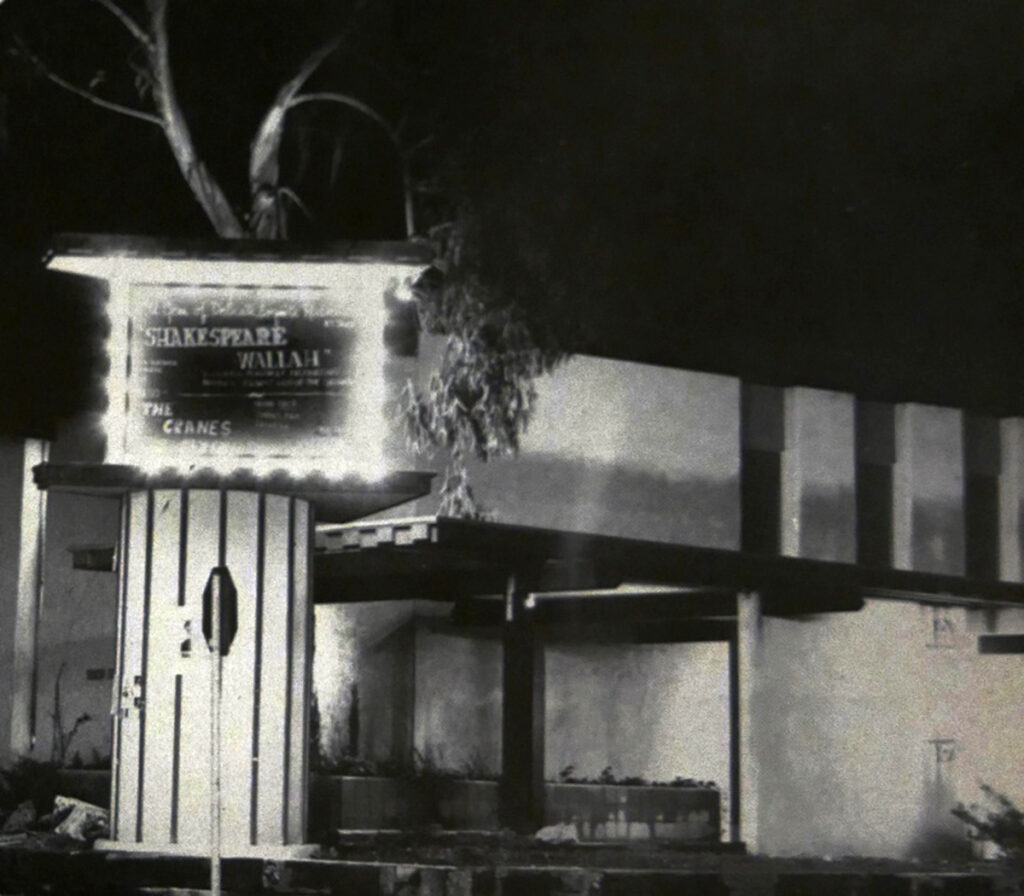
When the Magic Lantern Theater was raided by authorities and temporarily shut down for showing obscene films, tension between the students and the “Establishment” climbed higher.
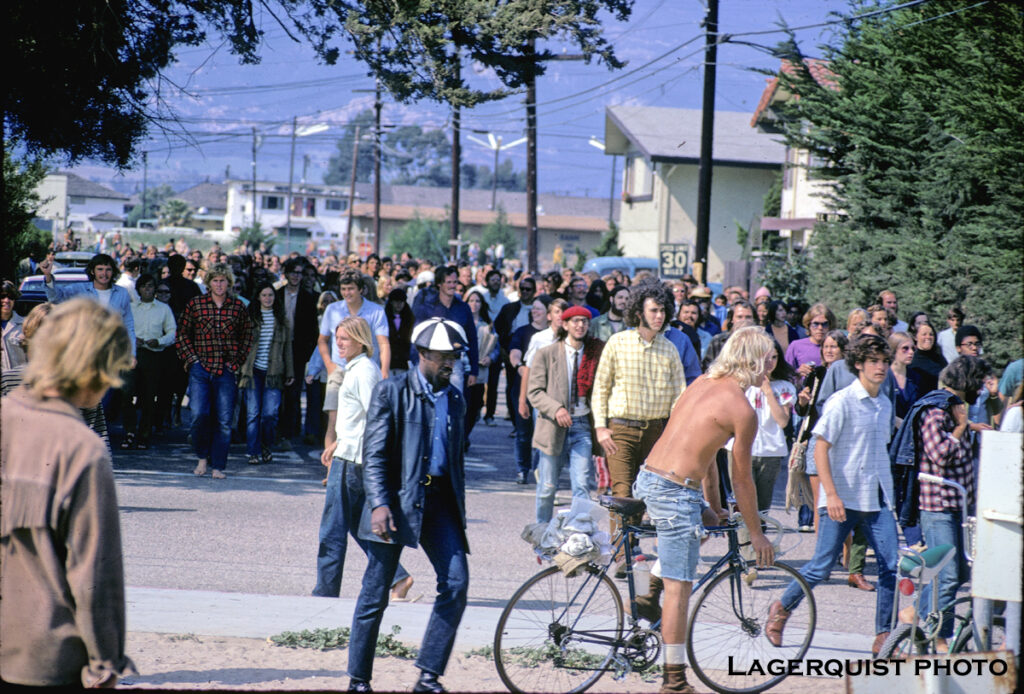
All the tension through the end of the 1960s came to a head in 1970 when Lefty Bryant, a popular local activist, was arrested. A large, angry crowd formed in the Embarcadero Loop and started vandalizing property and real estate. Local police were reinforced by an overly aggressive police force from Los Angeles, setting off a series of violent riots in Isla Vista.

The ongoing riots built up to a frenzy, resulting in the burning of the Bank of America in Isla Vista. This event made headlines across the nation and resulted in a heavy handed military police presence. Months of violent protests and riots dragged on through the summer of 1970.
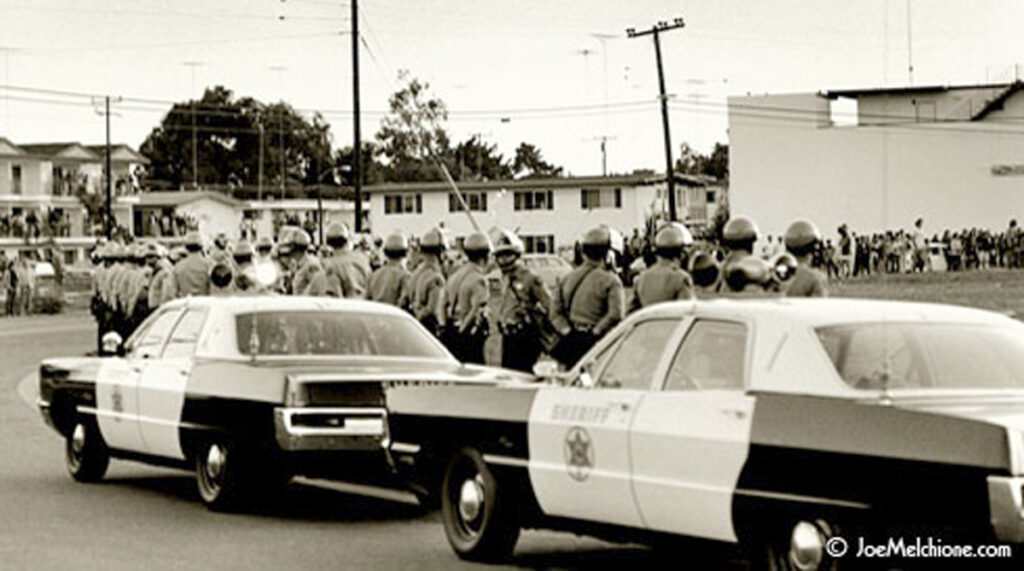
A lot has already been written about the I.V. riots and the burning of the bank, so we won’t go into much more detail here. This classic Joe Melchione photo captures the essence of it all. Riot police in the foreground, preparing to face the students in the distance, with the cheap Isla Vista apartments as a backdrop. If you want to learn more about the riots, click Here and Here.
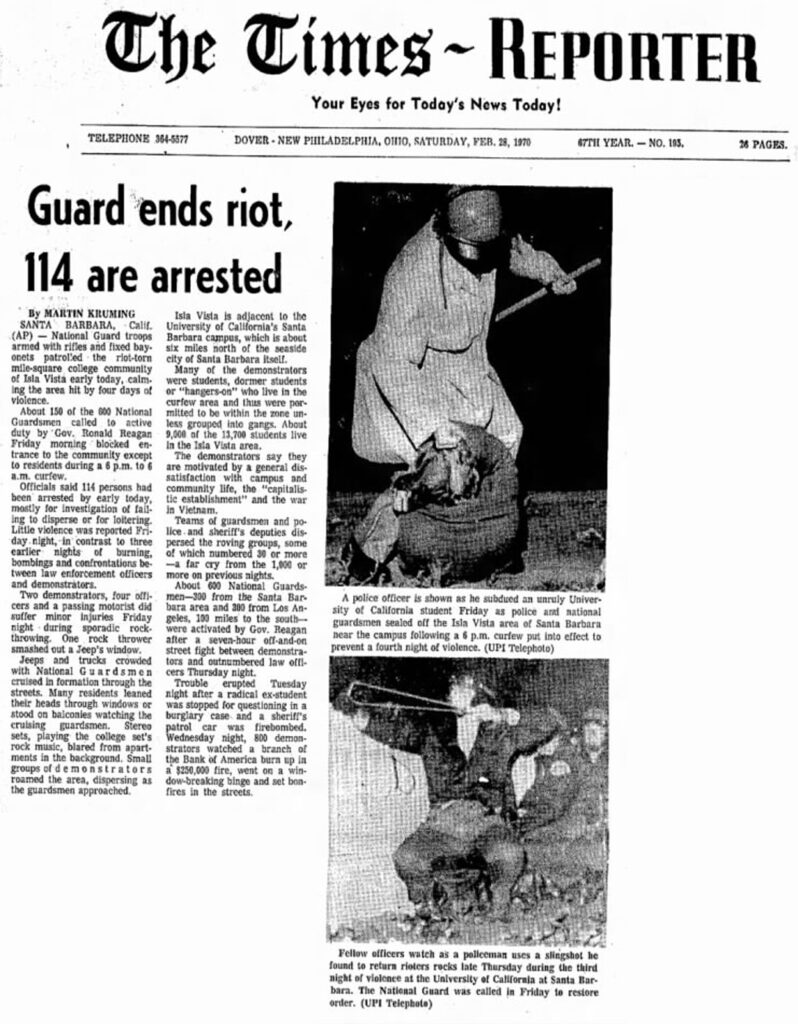
Eventually a student would be killed by police, causing even more riots and resulting in Governor Ronald Reagan sending the National Guard in to get control of the little beach town. More civil unrest happened around the state, and many people thought this was the beginning of a civil war, but thankfully things soon settled down. After the riots, the UC Regents issued the “Trow Report”, that had recommendations for the university to provide more community services, more housing for the students in Isla Vista, and to limit the student population.
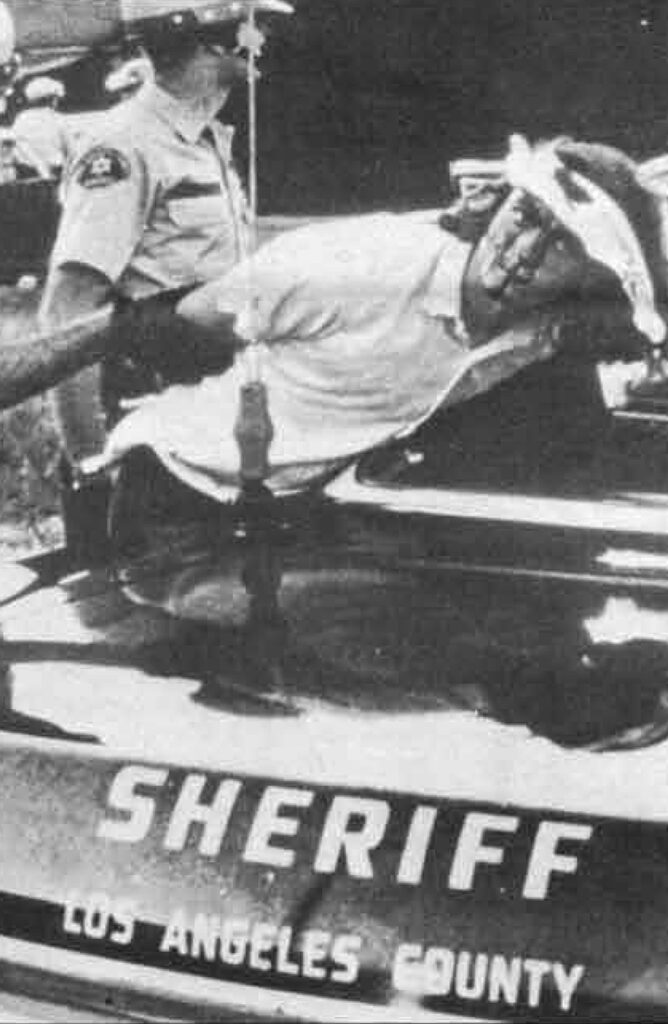
Limiting registration at UCSB was probably easy to do after newspapers all across the United States had been featuring college aged kids getting brutally beaten by authorities for months on end.
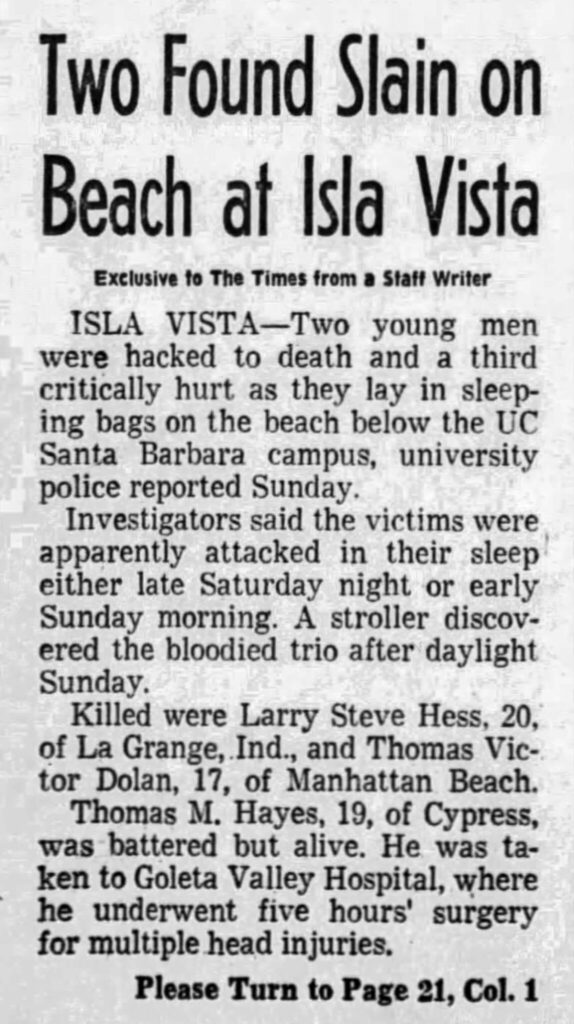
To make matters worse, a couple months after the riots settled down three young men sleeping on the beach at Isla Vista are brutally attacked, two of them dying on the scene. Nothing was stolen from the victims, and the case was never solved. Another reason the enrollment at UCSB took a dive for several years to come.

The Trow Report discovered what any student of history would have already known. The overbuilding and overcrowded conditions in Isla Vista were a big reason for the social unrest and it put the blame squarely on the university and the county. The report was especially hard on UCSB, pointing out how the university had ignored Isla Vista and they needed to actively participate in improving the quality of life there.
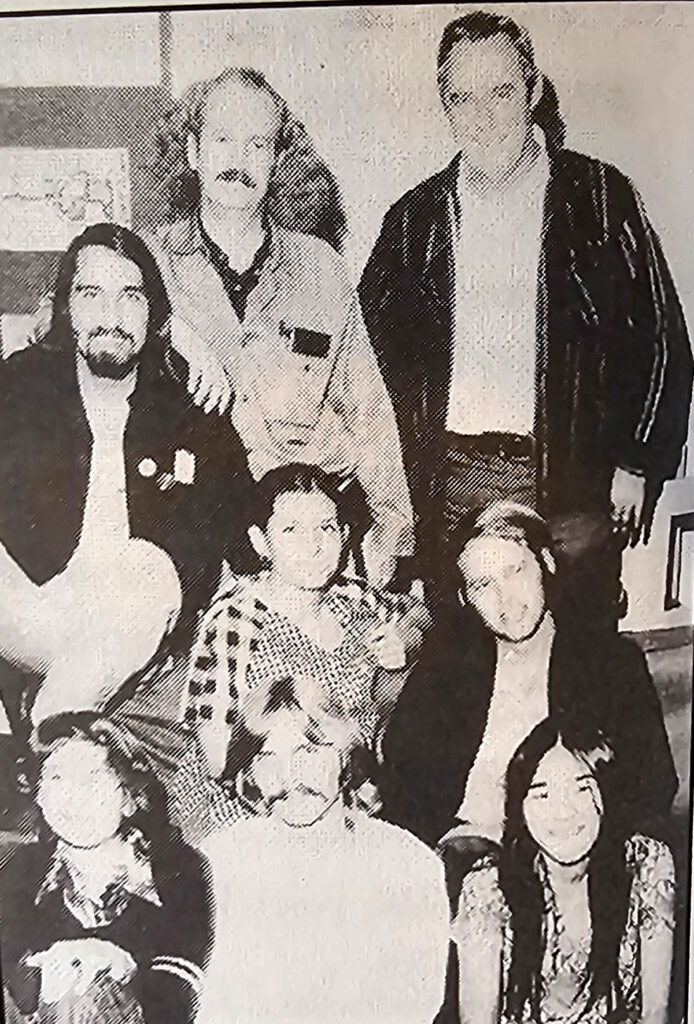
Several other studies were implemented and the general conclusion was that the citizens of Isla Vista had no control over their own community. Moving forward, Isla Vista received funding from the county and the university to create more civil organizations, like a medical clinic, a credit union, a community council and a foot patrol. The revitalized community was thought of optimistically as a “laboratory of social change”.
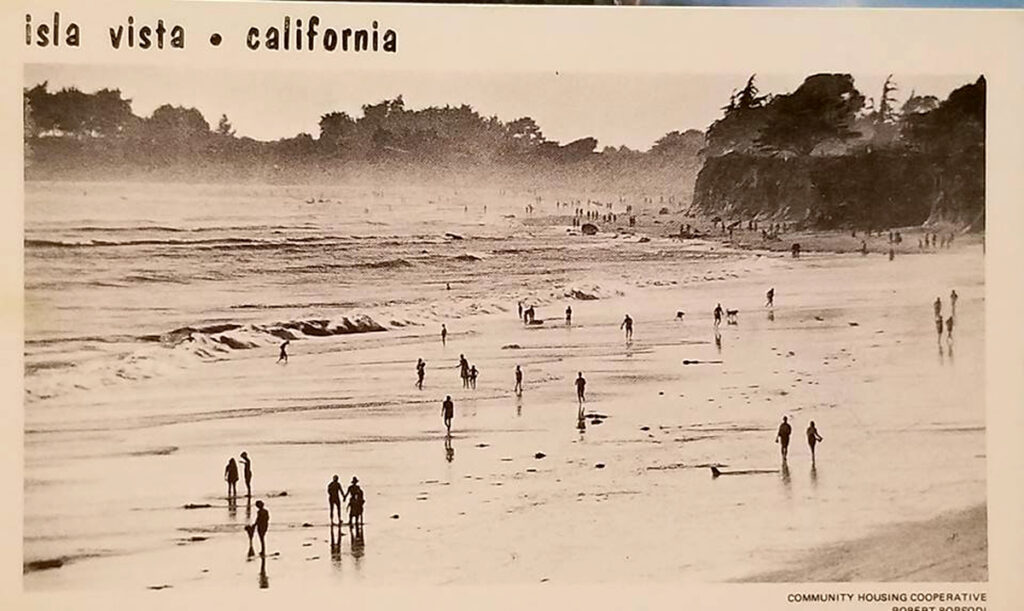
A renewed optimism and sense of community came to Isla Vista, as can be seen with these cool postcards.

So many cool things in this postcard. Notice the shape of those surfboards, the smiley face on the lifeguard tower and the teepee on the bluff.
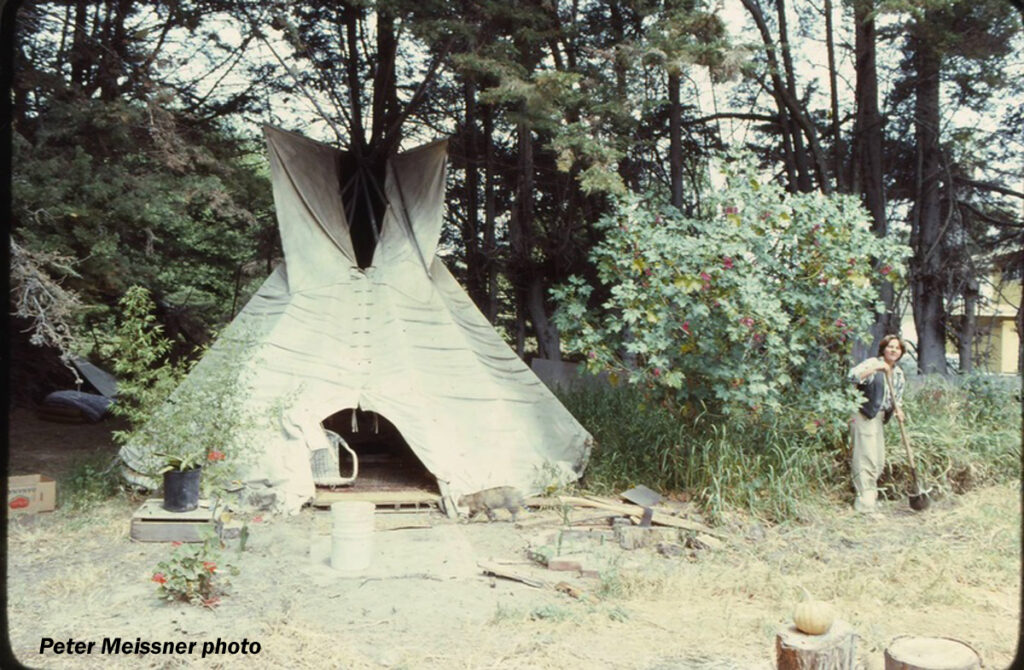
Teepees (or tipis) started popping up in the 1960s. A perfect setup for a hippy on the move, they could simply pick up their tipi and move if or when the landowner objected. In the late 1970s, Carmen Lodise says there were over 60 tipis in I.V., a direct response to the huge rent increases caused by the skyrocketing enrollment numbers at UCSB. Over 20 of the tipis were in “Tipi Village”, on a vacant lot on Sueno Road. They lived there happily for a while, eating vegetables from community gardens, and claiming it was low impact living, environmentally sound and better for the planet. Unfortunately, some neighbors disagreed, and the authorities shut the village down for sanitation reasons, despite several organized demonstrations to save them. Today there is a sign on the site, commemorating the Tipi Village.
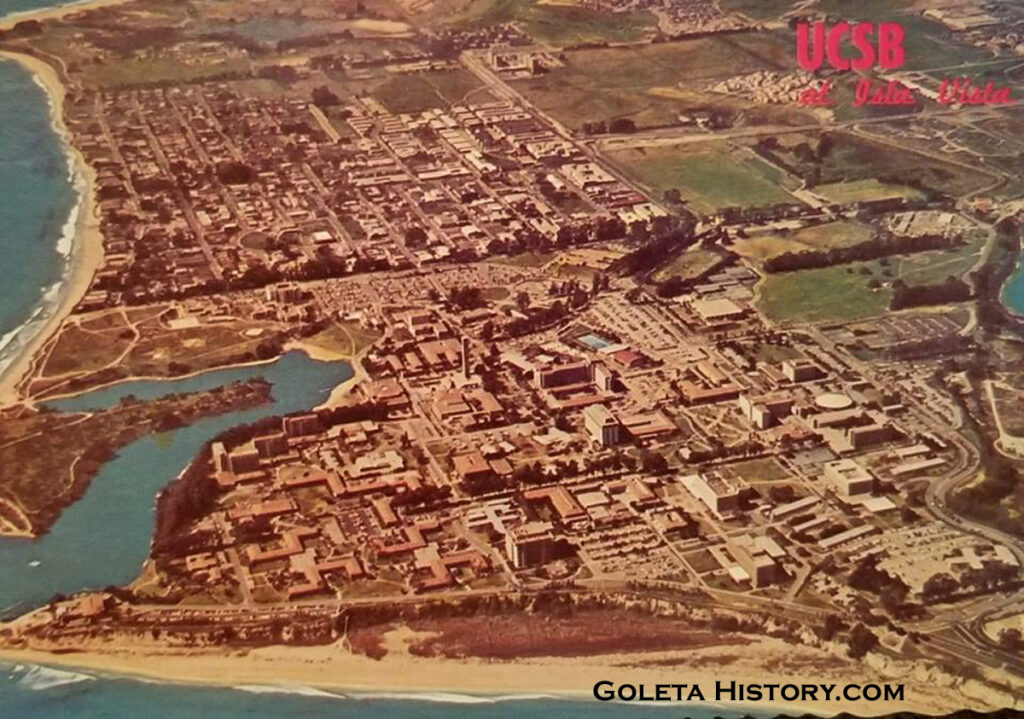
A lot did change for the better in Isla Vista in the coming decades, but the underlying fabric of the community was profit, from its inception. The narrow streets, overbuilt lots and lack of parking continue to be problematic issues to this day.

Another long lasting product of the greed fueled overdevelopment are the unsafe conditions on the Del Playa bluffs. This story from 1968 mentions an earlier report from 1962 that determined the cliffs were eroding rapidly, well before most of the building along the bluffs was even started.

By 1971, most of the tiny, oil drilling lots on the Del Playa bluffs were built on, most dangerously close to the edge. Most didn’t take advantage of the lot space towards Del Playa, probably to allow for parking.
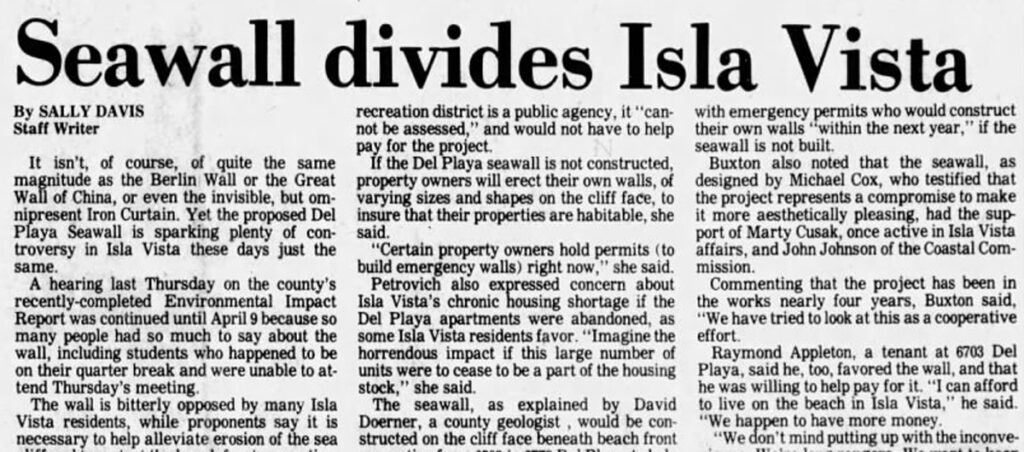
The cliff erosion and what to do about it has been an issue of debate for as long as there has been housing on the blufftops.
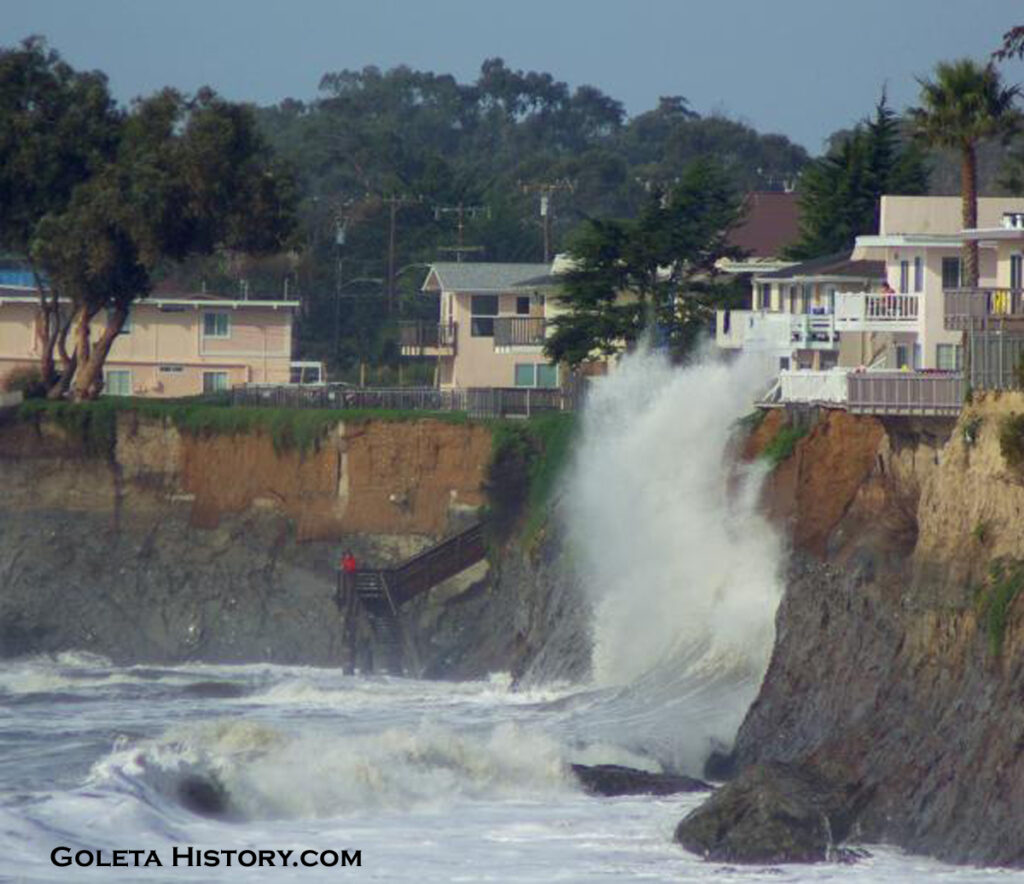
Mother Nature doesn’t seem to care, one way or the other. She just keeps doing her thing.

But time is running out for a lot of these units. For more info, the late Art Sylvester did an unparalleled study of local beach erosion, including the I.V. bluffs. See it HERE.
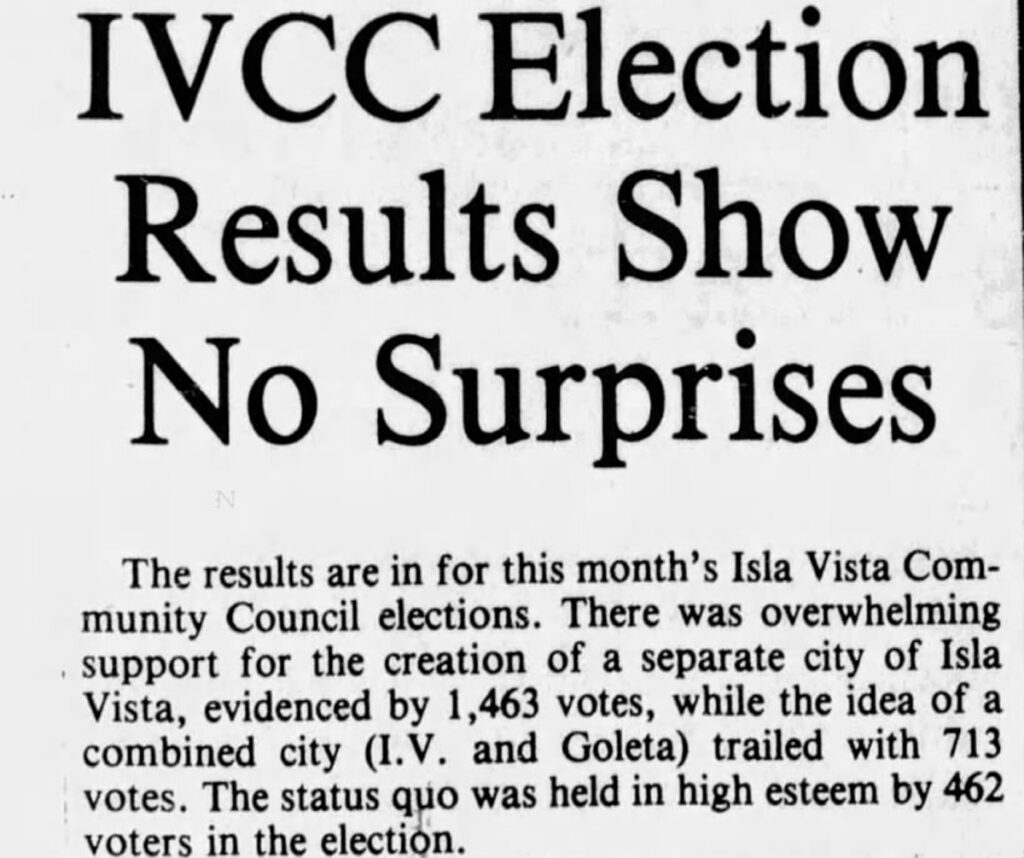
Through the years, several attempts to make I.V. a city have failed. When Goleta finally became a city, they went to great lengths to ensure the troubled Isla Vista was not within their city limits. With such a fluctuating population every year, it will probably never be anything more than an unincorporated bedroom community for UCSB students. Fortunately, community organizations still play a large role in Isla Vista today and the beachside location still makes it a lovely place to live.

The young energetic population of Isla Vista has never been short on creativity. Lots of famous rock bands like Rebelution, Lagwagon, Ugly Kid Joe, Jack Johnson and Iration all say they started out playing parties in I.V. Several very successful businesses also started on these crowded streets. A kid with frizzy red hair nicknamed “Kinko” got a $5,000 loan from the Bank of America in 1969, right before it was burned down! His business grew to be worth billions before being bought out by FedEx.
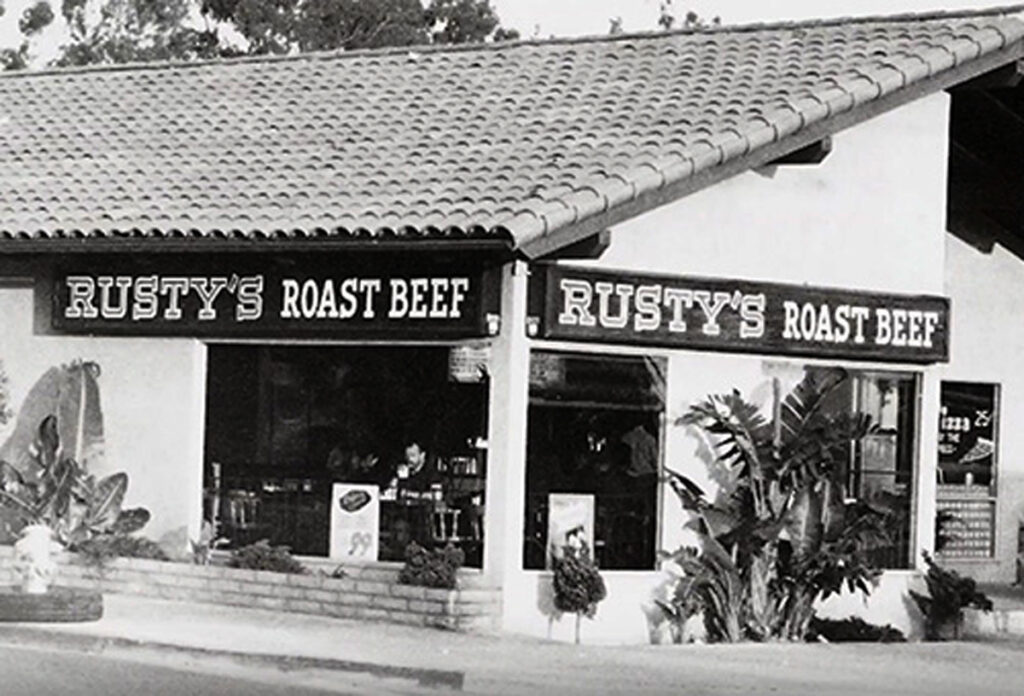
Another very popular local business started in I.V. The owners chose the name Rusty’s because the sign on the building was already there. They simply cut the roast beef off and started making the best darn pizza in town.
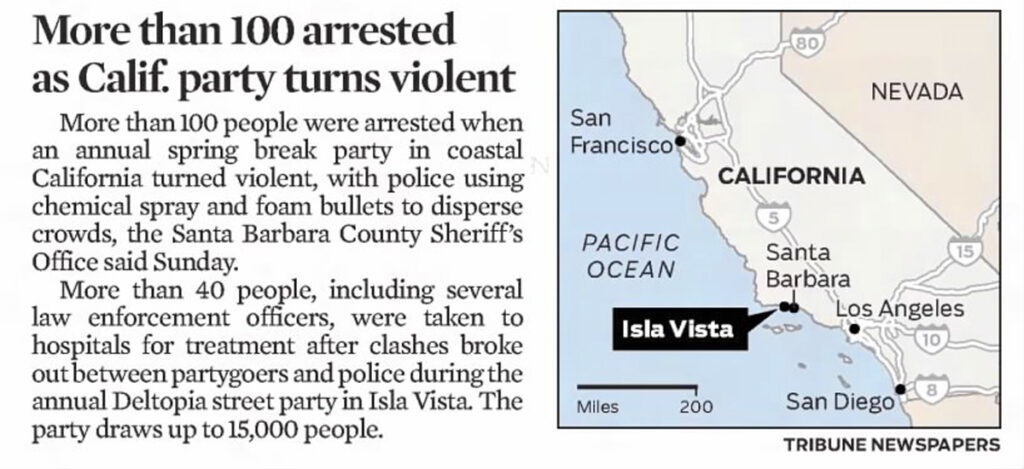
Isla Vista continues to occasionally make national news for all the wrong reasons. The attraction of a small beach town full of young people continues to draw crowds from all around the nation, often resulting in mayhem.
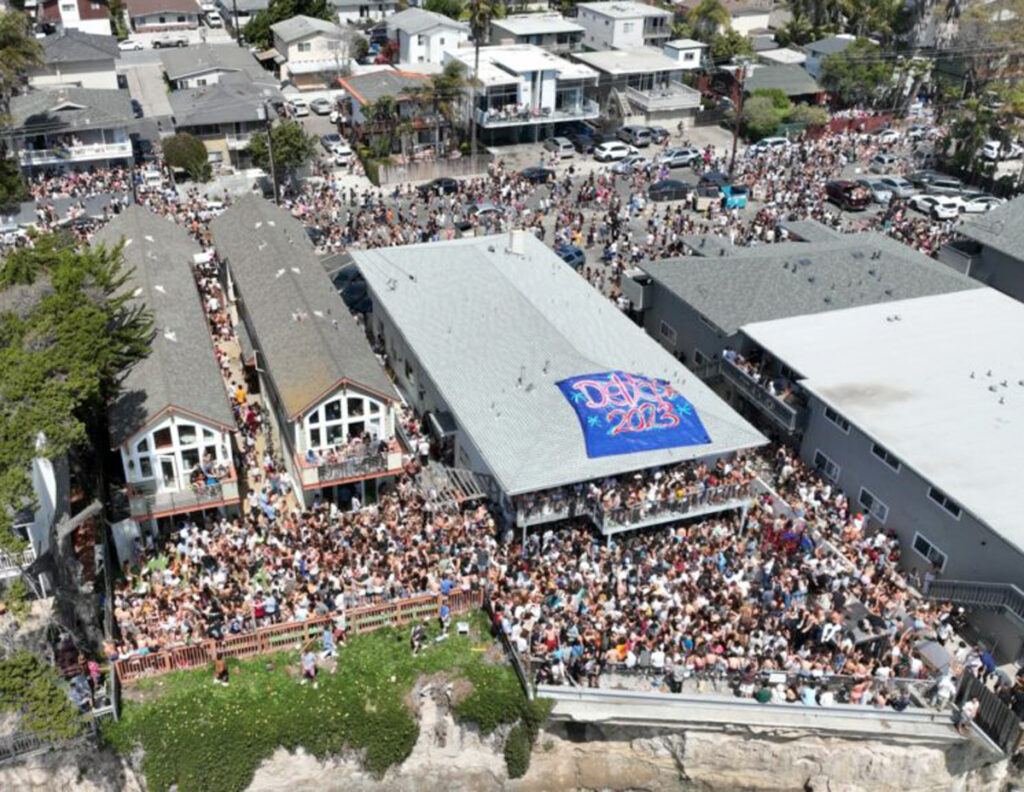
The local authorities continue to wrestle with controlling the latest Big Party, from Halloween to Deltopia, and they are usually outnumbered. UCSB being named the Best Party School, year in and year out, certainly doesn’t help.
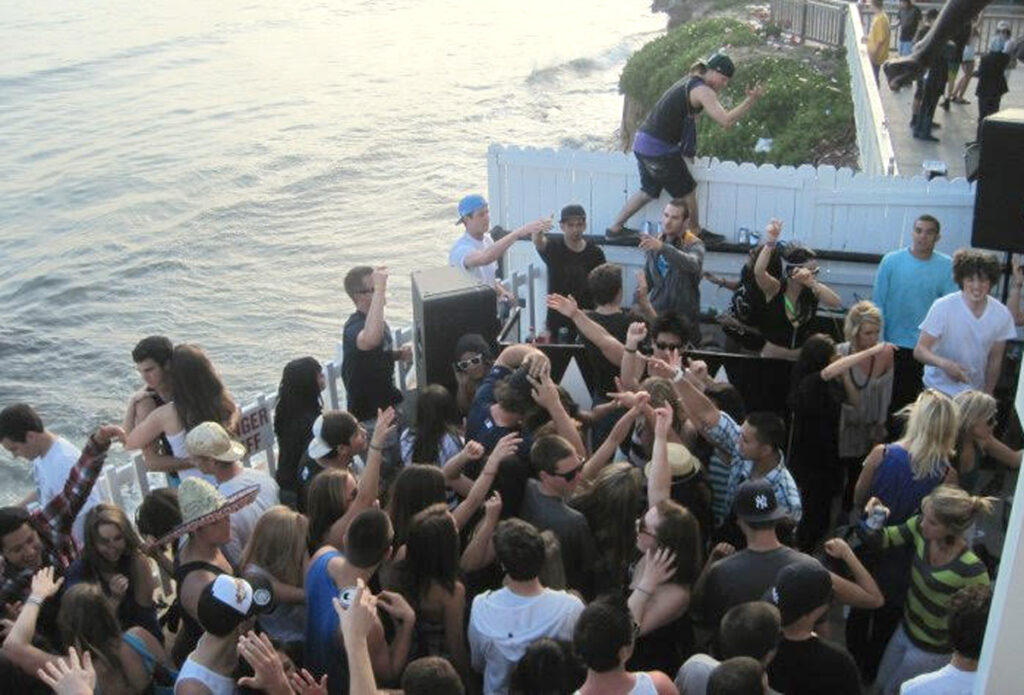
Throngs of rowdy out of towners added to the terminal overpopulation of a town teetering on the edge of the Pacific, any number of things can go wrong. Especially when you add alcohol.

Isla Vista has been a constant in the author’s life. As a child in the 1960s, my mother forbade me from going “out there”. As a teenager, that’s where we scored beer. As a college student, it was party central. And as an adult, it is town I rarely visit. Pictured above- my future wife and I enjoying a free concert in the People’s Park.
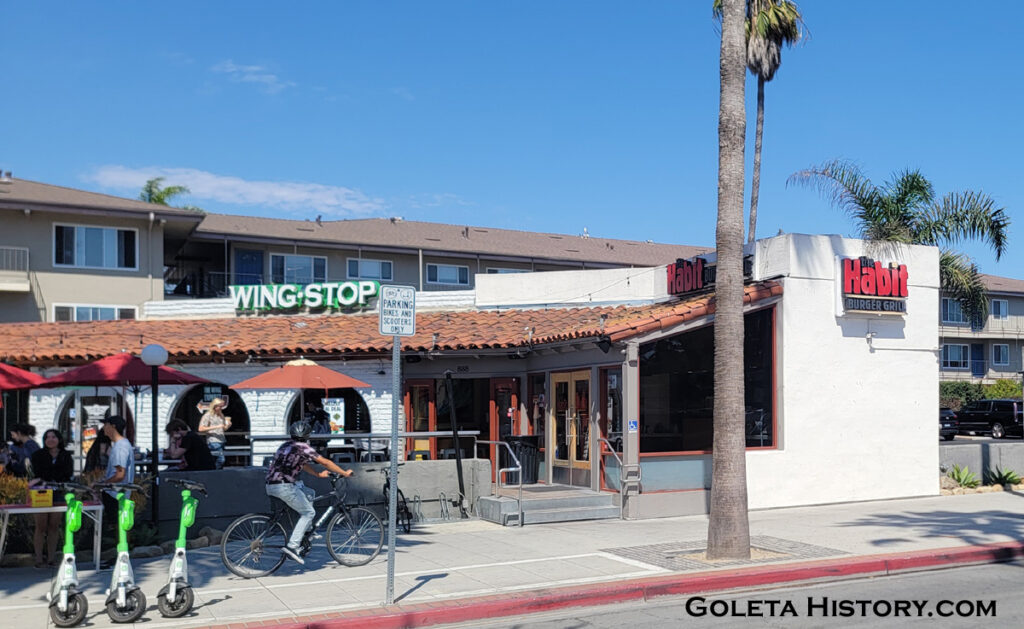
When making this page, I paid a visit and saw that while there were more corporate chains than ever before, I.V. is essentially the same old town. Small, dirty, crowded and bustling with activity.
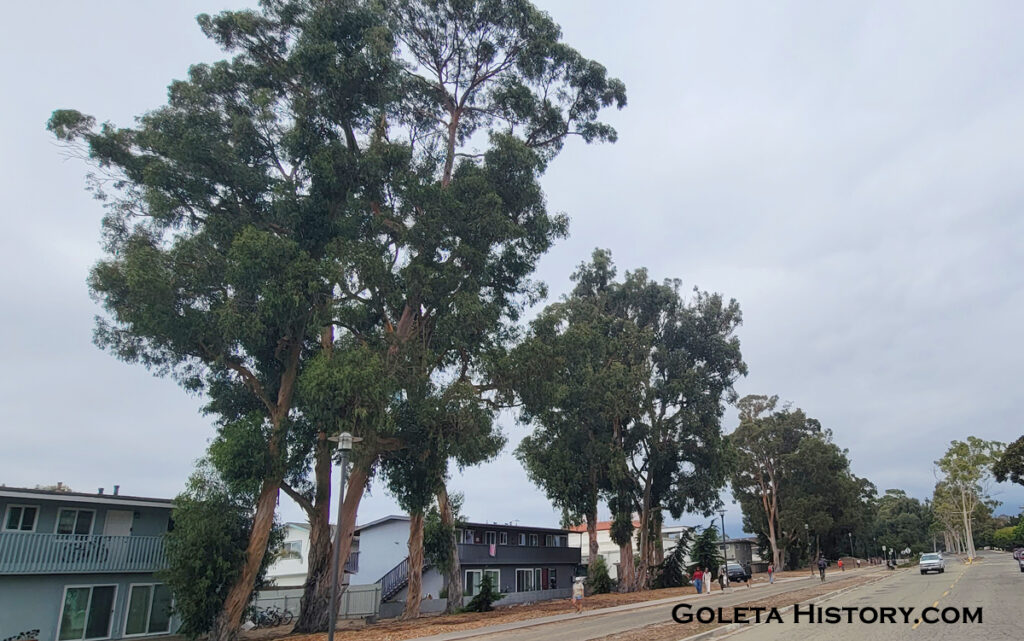
The Eucalyptus Curtain, planted by the Den brothers, is barely hanging in there.

The Welcome sign is looking a little tired….
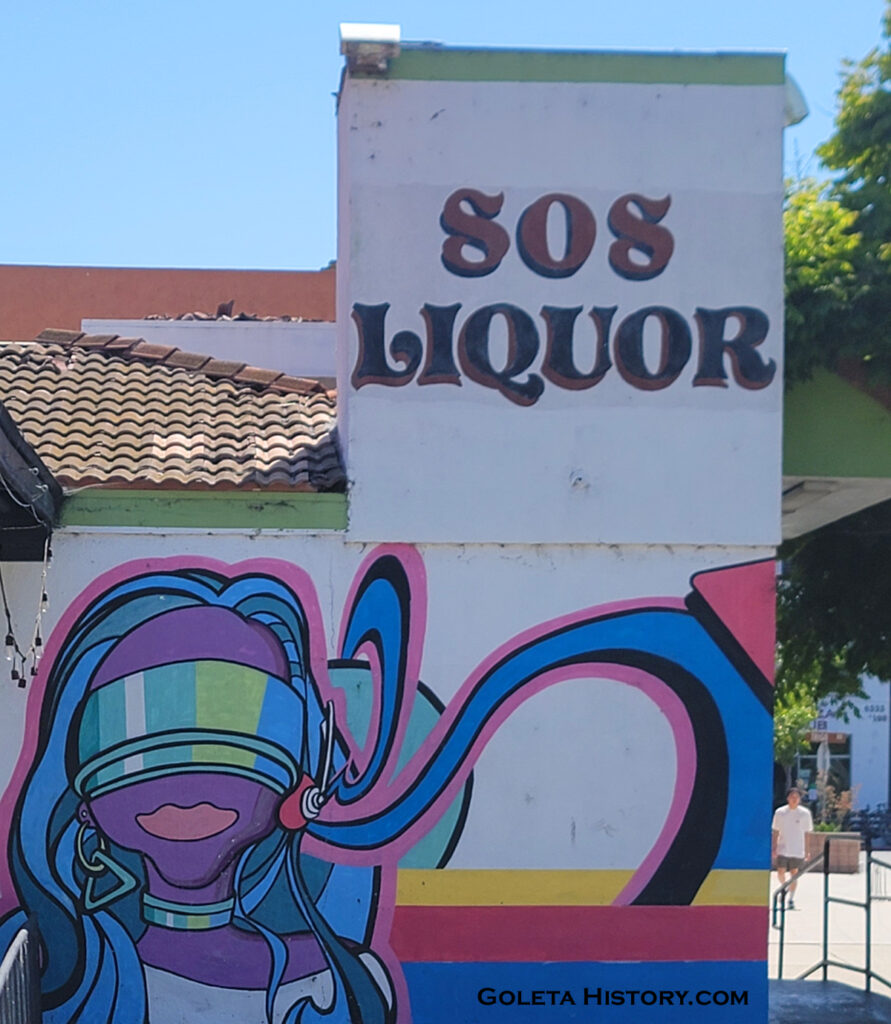
We noticed at least one local business that has been there since the 1970s. Originally called Sip Our Suds Beer, it was the first place allowed to sell beer after the riots. Still going strong selling one of the essentials of college life.
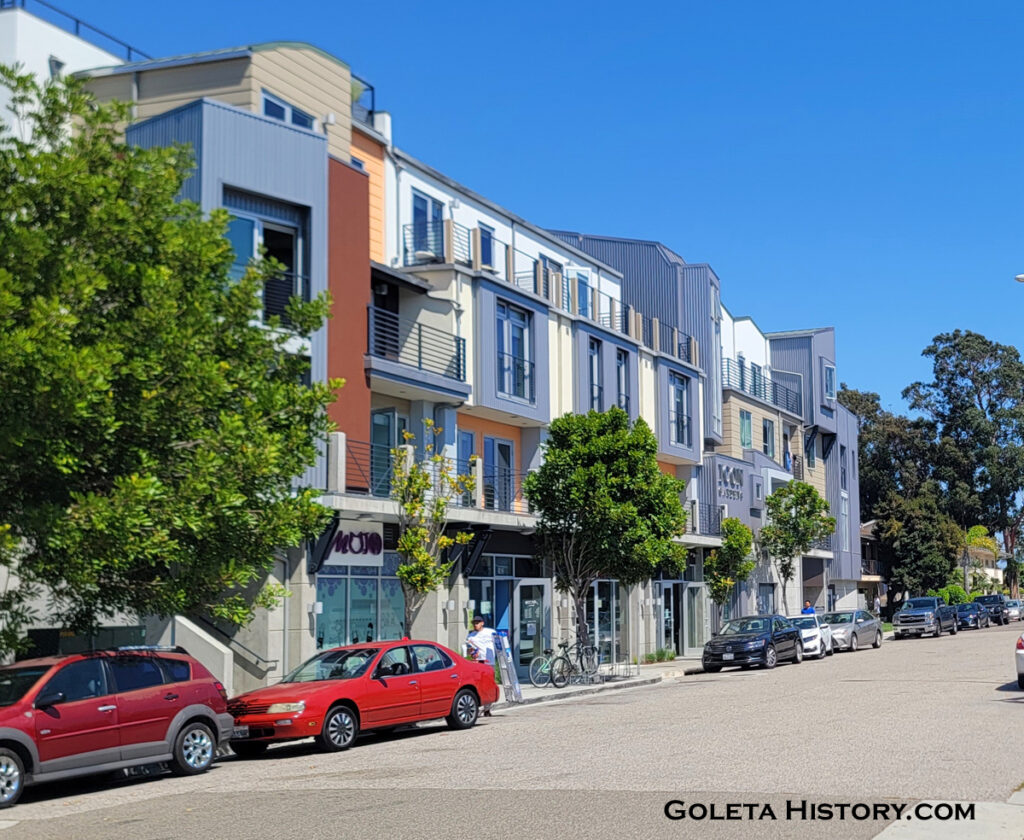
It appears the future for Isla Vista will be more of the same since UCSB continues to increase their enrollment and ignore the housing problem they create. Most likely the next phase for development will be demolishing the old, cheaply made apartments and replacing them with new, taller, cheaply made apartments.
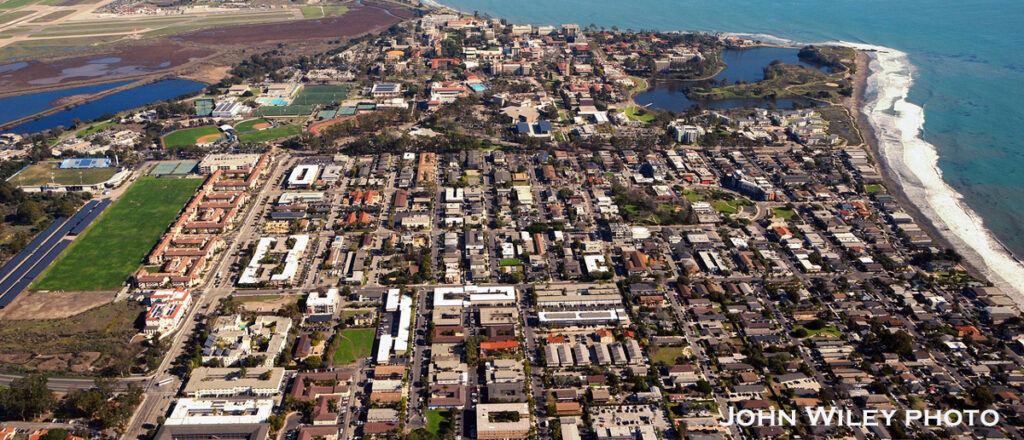
What would the Ilharreguys think of the result of their little plan for a seaside community? It was created out of a desire to make a profit, and surely thousands of investors have done just that. So in that respect, it was a success. But they had no way of knowing a major university would pop up right next door, drastically changing the course of history forever.

But Isla Vista is still a naturally beautiful place with a perfect climate, and nothing will ever change that.
PS- I could have made a whole page of just my own personal memories from I.V. We would love to hear your memories of Isla Vista, good or bad. Feel free to share them in the comments.
Sources- Walker Tompkins, Wikipedia, Isla Vista Free Press, Jon Erlandson, A Canyon Through Time, Mark Rochester, UCSB, Jennifer Hildreth Strand, Signal Hill Historical Society, Santa Barbara Library, Santa Barbara News Press, human.libretexts.org, Adam Lewis, Tom Lagerquist photos, Isla Vista Free Press, Carmen Lodise, Goleta Valley Sun, Rustyspizza.com, Santa Barbara Independent, John Wiley, Localwiki, Peter Meissner
Categories: Goleta History
Tom –
Again, a great article with loads of information gathered in one place for all us Goleta fanatics. A lot of your info was totally unknown to me, and I thank you for the in-depth history.
My dad was fond of mentioning that in the early thirties, just after he started playing professional baseball, he was offered several dozen acres of I.V. land for $2 an acre. He turned it down since that area was still greatly undeveloped and worthless for farming. He didn’t consider it a good investment.
I always look forward to your next outstanding post.
Best regards,
Tim
Thanks Tim. If your dad only had a crystal ball instead of a baseball!
Hi Tom – thank you for yet another great read. Some of my memories of I.V. include partying there on Halloween, walking the streets with all the crazies in various costumes. Probably a pretty dangerous endeavor. Haha! It always got out of hand and in most cases, law enforcement was called out. I do remember the bank burning, but I was only 11 years old and saw it on KEYT. My dad was a fire captain and told us all about it when he got home. The earlier back story and history was very interesting. The old map just above the whaling pic shows W. Begg plot right next to Mescalitan Island was owned by my great great grandfather William Begg. I love your articles! 🙂
Thanks!
I Toni lynn cheverez ,toni taylor ,Peterson..loved reading about I.V im 57 now I was 14 and had ran away from colona,Il hitched hiked with a friend and first went to sanjosethen ended up meeting Addie Greene.and Barbara Hunt and moved with addie and her parents to the apt .right at the T when you come into isla vista in 83 and ended up living in santa barbara 15 yrs plus 5 if my childrenwhere born at cottage hosp.twins kevin,Eric Shon, Zack and Lonnie Taylor and Christine Cheverez and later went home and had Jerry Dooley S.B.was my home growing up I had a lot of my best memorys were growing up on next to
beaches, and moutains,wild partys ,surf and sunshine those where the days the 80s..thanks for the history that for years Ive been telling storys of my childhood life .:)
Great article, thanks. I went to a film at the Magic Lantern the night the bank burned. Got out and students were swarming like ants everywhere. I thought Wow! I can’t wait til I go to college! Read about it in the paper in the morning.
Wow! that was a close call.
So many memories indeed. Bruce biting my thumb on trigo. Laura as pokey, me as gumby fighting the blockhead costumed couple on del playa. Kegs. Ceranitos fluatas and beer. The bus boys concert . A dog walking down the street with a hygiene product in its mouth. Egghead omlets. High-school lunch visits.
Tom,
Fantastic article! My family moved to Goleta in 76, but my grandparents had been in SB since the early 60’s and we had visited them since then. IV was an immediate attraction, and I thought of it as pretty old an established. Your article enlightened me to how “new” IV was in the mid 70s. So many memories there from high school era and into my college years when I would return to town. (I wrote an satire article in the Charger Account about Halloween in IV). My sister Wendy managed Perry’s pizza out there for a couple of years (meaning free pizza and beer…and video games). What a hoot it was. Thanks again for the history lesson on such a seminal part of my youth.
Haha, Perry’s Pizza! Oh yeah. Thanks Fred, I learned a lot making this. Id love to read your satire piece about Halloween, if you still have a copy, send it over!
Tom, this is a gorgeous piece of work. The infliction and overall tone of the piece is a cherry on top. Seriously- people like you remind me that the art of journalism isn’t dead.
Hi Tom, brings back a lot of memories and history of IV I did not know. I attended UCSB from 67 to 71. So much happened in that time period and now that I am 74 it all is getting a little fuzzy. But, there is enough history in that time period that you could weight another book. From the sports teams (I was playing water polo), to the BSU movement, summers of love, ROTC sit ins, riots and bank burning, surfing everyday from campus point to ins and out, and lastly the parties which were crazy (amazed I survived). Living now on the central coast and still feel this is the best place to live in the US, from SLO to Santa Barbara. If you ever want to hear more about that time contact me. Time of so much love and at the same time a period of a crazy war we saw everyday. Thanks for the article. Peace.
Thanks Bill, you certainly had a front row seat for a turbulent time in our nation’s history. Glad I could stimulate some memories!
What a great piece! I have lots of childhood/teen memories of IV. My parents started as college freshmen at UCSB in 1958. They initially lived downtown but were the first residents of their sorority and fraternity houses. I attended preschool at the UCSB child development center on the bluffs and some of my earliest vivid memories are from that school. It must have been the sound of the surf and the way the sunshine hit that seared that into my mind. Not bad! Later my mom became the chapter advisor for the Delta Gamma house and I awoke to a houseful of college girls who had escaped the BofA fire and took refuge at our house. Then there were the high school years, where we went looking for fun in IV and Evil Monkey always played a part. Thanks for all of the early history, it’s always fun to learn new things from your columns.
Very cool memories Funky, thanks for sharing!
My wife was 9 months pregnant, I was teaching at La Colina, and we lived on Pasado in a duplex. Coming home from work, I was stopped by police at Hollister and not allowed to enter IV, without proof that I lived there. I didnt have a wallet and of course no cellphone. I set out cross-country as soon as I was out of sight and hiked home. I saw police everywhere, and heard lots of yelling so I ventured over three blocks to the Loop and could see a large crowd around the B of A…. the bank was open and people were walking in and out and I realized there was no one there, no employees and no police…just “students” reeking havoc inside the bank. I jogged home told my wife you gotta see this and we walked over and hand in hand we walked into and through the bank out to the East side entrance. Soon some fellas rolling a dipsy dumpster down the loop and arrived at the front door. where they shoved it inside. smoke began to come out the door and then all the people inside ran out excitedly yelling for everyone to get back get back and moments later a huge muffled explosion blasted us across the street. The fire spread quicky and we heard that there were 55 gal drums in the dumpster full of used oil… within 15 min there was a tongue of blue and orange flames the size of the doorway blowing fire and heat across the street where telephone poles began so smoke on their west facing sides. The fire department never showed. police drove up and turned around and left and it burned thru the night, I stayed behind and watched it all collapse into ashes except for the large square vault…. … it was one of the most incredible experiences of my life, and as the story goes on we all paid the price with disrupted lives for several years….. I was arrested once and never indicted. The disruption and rioting that followed along with the birth of my son gave us the push we needed to move to Southern Oregon and reclaim our peaceful child rearing lives again.
Wow, great memories Bullet. Thanks for sharing!
Tom—
A great read. My long time friend and sometime roommate, Bill O’Neal, sent this to me. I was at UCSB from 1959 to 1963 and again from 1965 to 1967. I chose it over UCLA because I wanted to be further from home in Altadena and my Dad worked for the company that did the UCSB Master Plan. I came up with him to have a look and he showed me the almost finished Anacapa Hall. Dorm Room with a view? Sure, said I.
I ended up getting a teaching job in Santa Barbara at La Cumbre Junior High and stayed there until 2002 after 35 years.
Thanks for the memories.
PS The teacher in me found only one error. It’s Pasado not Pasada. The worst mangling of Spanish is Sábado Tarde.
Thanks Frank, for the memories, And the correction! Done.
My family landed in Western Goleta in 1968, I was only 10 years old, and I have watched IV change over the years. My first memory was around 1970, we needed to copy some sheet music, and mom took us to a place in IV called Kinko’s, I remember it as a small shack with a copy machine. I got my drivers license in 1974 and this was the place to go, I wasn’t into the party scene, but it had the energy that drew us to it. After a stint in the Navy, I experienced my first Isla Vista Halloween, I was 21 and open containers were allowed if you were of age. WOW what a party! I now live in Oxnard, but make regular visits to my mother who has lived in Isla Vista’s Freindship Manor Retirement Home for the past 8 years.
Great memories Paul, thank you.
What a great slice of local history! I love the pieces being stitched together, imagining what IV looked like during the pre-Cachuma-water years! Where did the Marines get their water?
I moved from Socal to IV to attend UCSB in 1975, much to the consternation of various adults in my life (“Don’t they have riots there?!?”) I missed all the riots, sit-ins and be-ins. But it was independence heaven, living three blocks from the Camino Pescadero stairway to the sea, and next door to Rosie’s Ice Cream. I also enjoyed playing scrabble and drinking Moka mit Schlag, at Borsodi’s, (oh so very exotic.) Buying trail mix from the bulk bins at Sunburst, and sandals from the Isla Vista Leather Guild sealed my new life as an over-all wearing, vw-van driving college student of the ’70’s. I also lived for a while on the far western end of Abrego, near TP village. I totally remember the gal in your TP village photo, I’m pretty sure her name is Moira.
I left IV in 1979 and almost never went there again until in the 2000’s, when I worked at UCSB and decided to renew my membership at IV Food Coop. It’s still a great place to shop, with excellent local produce.
Thanks for the bigger picture view. I really appreciate your work, Tom.
Thank you for the personal history. Great memories. Sounds like you were a groovy little hippy gal!
Oh quite! 😉
Thanks Tom.
Loved this read and learned a lot. You are a teacher and scholar. I don’t think anyone at that fancy university could have done it as well. Love the picture of you and Kim.
Haha, Thanks Ed. You are now my best student.